模式识别受体通路
模式识别受体是什么?

模式识别受体是什么?
模式识别受体(Pattern recognition receptors,PRRs)是机体先天免疫系统的重要组成部分,存在形式多样,不仅仅在细胞膜上表达,内体膜、溶酶体膜和胞质中也同样分布广泛。
他们的作用是,监测病毒分子的存在、启动机体炎症反应和抗病毒免疫的信号传导通路,使宿主免受感染。
病毒入侵宿主细胞后,利用细胞内的碱基成分产生新的病毒基因组,病毒复制中间体的形成和堆积,形成了病毒核酸的主要病原相关分子模式(pathogen-associated molecular patterns,PAMP),而这些分子就是PRRs所识别的对象。
PRRs包括T oll样受体TLR、RIG-I样受体(RLR)和NOD样受体(NLR),这些PRRs通过激活相关抗炎通路诱导细胞因子和干扰素的产生,从而激发机体的抗病毒反应。
目前研究比较多的是通过PRRs 监测受感染细胞内的病毒DNA,也有研究表明,RNA聚合酶III(Pol III)可将某些病毒DNA转录为RNA,而被宿主RIG-I识别受体所识别,诱导IFN的产生。
模式识别受体PPT课件
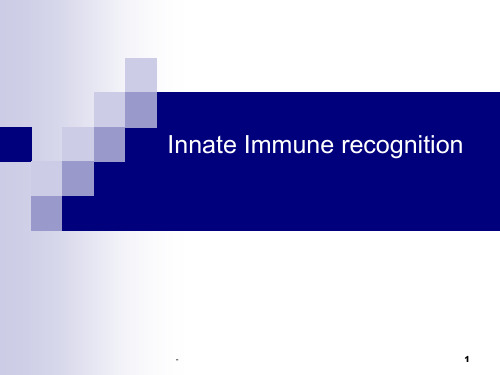
-
29
Ubiquitin (泛素)对PRR信号的调节
泛素由76个氨基酸残基组成,其中包括7个赖氨酸残基(K), 其C末端可与 底物的赖氨酸残基形成异肽键,从而引起底物泛素化。泛素的K11、K29 、K48和K63均能参与形成泛素与泛素间的异肽键 (Isopeptide bond)。
-
3030
Ubiquitination for RIG-I signaling
Fujita T
-
25
2-2) structure of RIG-I
RIG-I 结合 5’-ppp dsRNA
-
26
MAVS: adapter for RIG-I
Seth, R.B., Sun, L., Ea, C., and Chen, Z.J., "Identification and characterization of MAVS: a mitochondrial antiviral signaling protein that activates NF-κB and IRF3." Cell, 122:669-682, 2005
has been shown to induce the innate immune response in adult Drosophila. Like Drosophila Toll, human Toll is a type I transmembrane protein with an extracellular domain consisting of a leucine-rich repeat (LRR) domain, and a cytoplasmic domain homologous to the cytoplasmic domain of the human interleukin (IL)-1 receptor. Both Drosophila Toll and the IL-1 receptor are known to signal through the NF-kappaB pathway. We show that a constitutively active mutant of human Toll transfected into human cell lines can induce the activation of NF-kappaB and the expression of NF-kappaB-controlled genes for the inflammatory cytokines IL-1, IL-6 and IL-8, as well as the expression of the co-stimulatory molecule B7.1, which is required for the activation of naive T cells.
toll样受体信号通路

Toll 样受体(TLRs)是一个模式识别受体家族,它们在进化上高度保守,从线虫到哺乳动物都存在TLRs,目前在哺乳动物中已发现 12 个成员[1].TLRs 主要表达于抗原递呈细胞及一些上皮细胞,为玉型跨膜蛋白,胞外区具有富含亮氨酸的重复序列,能够特异识别病原微生物进化中保守的抗原分子———病原相关分子模式 (pathogen-associatedmolecular patterns, PAMPs)[2].为了有效地抵抗入侵的病原体,机体需要对多种 PAMPs产生适当的免疫应答,TLRs 可以通过识别 PAMPs诱发抵抗病原体的免疫反应.而且 TLRs 也参与识别有害的内源性物质.TLRs 的激活可诱导很强的免疫反应,有利于机体抵抗病原体感染或组织损伤,但是过度的免疫反应也会带来不利影响,如产生内毒素休克、自身免疫性疾病等.为了保证 TLRs 介导正确的免疫应答,机体存在精密的负调控机制,及时抑制 TLRs 信号,维持机体的免疫平衡[3]TLR 家族成员(TLR3 除外)诱导的炎症反应都经过一条经典的信号通路(图 1),该通路起始于TLRs的一段胞内保守序列———Toll/IL-1 受体同源区(Toll/IL-1 receptor homologousregion,TIR).TIR可激活胞内的信号介质———白介素 1 受体相关蛋白激酶(IL-1R associated kinase, IRAK) IRAK-1 和IRAK-4、肿瘤坏死因子受体相关因子 6(TNFR-associated factor 6, TRAF-6)、促分裂原活化蛋白激酶(mitogen activated protein kinase,MAPK)和 I资B激酶 (I资B kinase, I资K ),进而激活核因子资B(nuclear factor 资B,NF-资B),诱导炎症因子的表达.TLRs 信号通路上的许多接头蛋白都具有 TIR结构域:髓系分化因子 88(myeloid differentiationfactor 88, MyD88)、 MyD88- 接头蛋白相似物(MyD88-adaptor like,Mal)、含有 TIR 结构能诱导干扰素茁的接头分子 (TIR domain-containingadaptor inducing interferon茁,TRIF)、TRIF 相关接头分子(TRIF-related adaptor molecule,TRAM)和SARM (sterile 琢 and armadillo motif-containingprotein)[4].它们参与 TLRs 所介导的信号转导,其中 MyD88最重要,参与了除 TLR3 外所有 TLRs介导的信号转导.MyD88首先通过 TIR 与 TLRs 相结合,接着募集下游信号分子 IRAK-4,IRAK-4 磷酸化激活IRAK-1,随后活化 TRAF6.活化的 TRAF6具有泛素连接酶(E3)的活性,能够结合泛素结合酶(E2),进而泛素化降解 IKK-酌.这种泛素化降解可以活化TGF-茁激酶(TGF-茁activated kinase 1, TAK1) 和TAK1结合蛋白 (TAK1 binding protein,TAB1、TAB2、TAB3).活化的 TAK1 会催化 IKK-茁磷酸化,最终激活 NF-资B,促使炎症因子的表达.除了共同的 NF-资B 激活通路,不同的 TLRs 还存在着其特有的信号通路,一些 TLRs 具有募集 Mal、TRAM 和 TRIF 的作用.不同的接头分子在信号传导中发挥的作用不同[5],TRIF 在脂多糖(LPS)激活的 TLR4 途径和 Poly(I∶C)激活的 TLR3 途径中都起到了重要的作用,而 TRAM 仅在 TLR4 的途径中发挥作用.TLRs 的激活是一把双刃剑,它可以通过刺激先天性免疫应答和提高获得性免疫反应来保护机体,但是它所引起的持续性炎症反应也会对机体产生损伤,自身免疫、慢性炎症和感染性疾病都与它有一定关系.例如 LPS 持续刺激 TLR4 就可以引起严重的败血病和感染性休克,此外,类风湿性关节炎、慢性阻塞性肺心病、结肠炎、哮喘、心肌病、狼疮和动脉粥样硬化的发生也与 TLRs 的激活有关.因此 TLRs 的激活必须受到严格的负调控,以保持免疫系统的稳定.对于负调控机理的研究是近几年免疫学的热点,以下将介绍 TLRs 负调控的研究进展(图 1).。
模式识别受体在动脉粥样硬化中的作用及相互关系-中国动脉硬化杂志
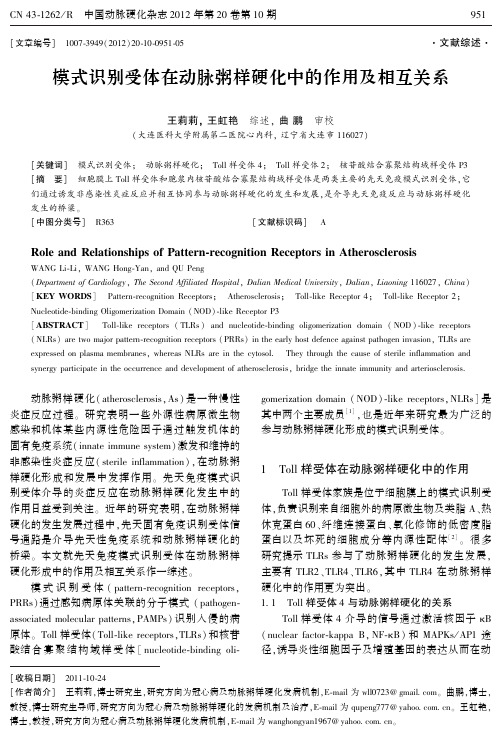
[文章编号] 1007⁃3949(2012)20⁃10⁃0951⁃05㊃文献综述㊃模式识别受体在动脉粥样硬化中的作用及相互关系王莉莉,王虹艳 综述,曲鹏 审校(大连医科大学附属第二医院心内科,辽宁省大连市116027)[关键词] 模式识别受体; 动脉粥样硬化; Toll样受体4; Toll样受体2; 核苷酸结合寡聚结构域样受体P3 [摘 要] 细胞膜上Toll样受体和胞浆内核苷酸结合寡聚结构域样受体是两类主要的先天免疫模式识别受体,它们通过诱发非感染性炎症反应并相互协同参与动脉粥样硬化的发生和发展,是介导先天免疫反应与动脉粥样硬化发生的桥梁㊂[中图分类号] R363[文献标识码] ARole and Relationships of Pattern⁃recognition Receptors in AtherosclerosisWANG Li⁃Li,WANG Hong⁃Yan,and QU Peng(Department of Cardiology,The Second Affiliated Hospital,Dalian Medical University,Dalian,Liaoning116027,China) [KEY WORDS] Pattern⁃recognition Receptors; Atherosclerosis; Toll⁃like Receptor4; Toll⁃like Receptor2; Nucleotide⁃binding Oligomerization Domain(NOD)⁃like Receptor P3[ABSTRACT] Toll⁃like receptors(TLRs)and nucleotide⁃binding oligomerization domain(NOD)⁃like receptors (NLRs)are two major pattern⁃recognition receptors(PRRs)in the early host defence against pathogen invasion,TLRs are expressed on plasma membranes,whereas NLRs are in the cytosol. They through the cause of sterile inflammation and synergy participate in the occurrence and development of atherosclerosis,bridge the innate immunity and arteriosclerosis. 动脉粥样硬化(atherosclerosis,As)是一种慢性炎症反应过程㊂研究表明一些外源性病原微生物感染和机体某些内源性危险因子通过触发机体的固有免疫系统(innate immune system)激发和维持的非感染性炎症反应(sterile inflammation),在动脉粥样硬化形成和发展中发挥作用㊂先天免疫模式识别受体介导的炎症反应在动脉粥样硬化发生中的作用日益受到关注㊂近年的研究表明,在动脉粥样硬化的发生发展过程中,先天固有免疫识别受体信号通路是介导先天性免疫系统和动脉粥样硬化的桥梁㊂本文就先天免疫模式识别受体在动脉粥样硬化形成中的作用及相互关系作一综述㊂模式识别受体(pattern⁃recognition receptors, PRRs)通过感知病原体关联的分子模式(pathogen⁃associated molecular patterns,PAMPs)识别入侵的病原体㊂Toll样受体(Toll⁃like receptors,TLRs)和核苷酸结合寡聚结构域样受体[nucleotide⁃binding oli⁃gomerization domain(NOD)⁃like receptors,NLRs]是其中两个主要成员[1],也是近年来研究最为广泛的参与动脉粥样硬化形成的模式识别受体㊂1 Toll样受体在动脉粥样硬化中的作用Toll样受体家族是位于细胞膜上的模式识别受体,负责识别来自细胞外的病原微生物及类脂A㊁热休克蛋白60㊁纤维连接蛋白㊁氧化修饰的低密度脂蛋白以及坏死的细胞成分等内源性配体[2]㊂很多研究提示TLRs参与了动脉粥样硬化的发生发展,主要有TLR2㊁TLR4㊁TLR6,其中TLR4在动脉粥样硬化中的作用更为突出㊂1.1 Toll样受体4与动脉粥样硬化的关系Toll样受体4介导的信号通过激活核因子κB (nuclear factor⁃kappa B,NF⁃κB)和MAPKs/AP1途径,诱导炎性细胞因子及增殖基因的表达从而在动[收稿日期] 2011⁃10⁃24[作者简介] 王莉莉,博士研究生,研究方向为冠心病及动脉粥样硬化发病机制,E⁃mail为wll0723@㊂曲鹏,博士,教授,博士研究生导师,研究方向为冠心病及动脉粥样硬化的发病机制及治疗,E⁃mail为qupeng777@㊂王虹艳,博士,教授,研究方向为冠心病及动脉粥样硬化发病机制,E⁃mail为wanghongyan1967@㊂脉粥样硬化的形成与发展中起重要作用㊂当细胞外的炎症刺激因子与TLR4结合后将信号转导到胞内,TLR4的胞内区与髓样分化因子88(myeloid dif⁃ferentiation factor88,MyD88)结合,同时MyD88与白细胞介素1受体相关激酶(interleukin⁃1receptor⁃as⁃sociated kinase,IRAK)结合,激活IRAK自身的磷酸化,获得游离的IRAK1㊁IRAK2和IRAK4继而激活肿瘤坏死因子受体相关因子6[tumor necrosis factor (TNF)receptor⁃associated factor⁃6,TRAF⁃6],TRAF⁃6又进一步激活NF⁃κB抑制物的激酶(IKKs)复合物使IkB磷酸化,磷酸化的IkB发生泛素化而降解,最终导致NF⁃κB的活化㊂NF⁃κB是重要的炎症调节因子,能够启动细胞内炎症因子肿瘤坏死因子ɑ(tumor necrosis factor⁃ɑ,TNF⁃ɑ)㊁白细胞介素1(in⁃terleukin⁃1,IL⁃1)㊁IL⁃6㊁IL⁃12等的级联样式放,参与动脉粥样硬化形成的炎症反应㊂Michelsen等[3]较早报道了TLR4与动脉粥样硬化形成的直接关系,研究中发现TLR4/ApoE及MyD88/ ApoE双基因缺陷鼠与载脂蛋白E(apolipoprotein E, ApoE)缺陷鼠相比动脉硬化程度有明显减轻,提示TLR4信号通路参与了动脉粥样硬化的形成;同时他的研究中还发现TLR4/ApoE和MyD88/ApoE双基因缺陷鼠动脉粥样硬化斑块组织处的巨噬细胞聚集及脂质沉积均较ApoE缺陷鼠要轻,进一步提示TLR4可能参与了动脉硬化的斑块进展阶段㊂Methe等[4]发现急性心肌梗死和不稳定型心绞痛患者与健康对照者相比外周血单核细胞TLR4的mRNA及蛋白表达水平有明显升高,并且急性心肌梗死患者斑块破裂处局部的TLR4水平较外周血单核细胞更高,提示TLR4与动脉粥样硬化的发生及斑块易损破裂都有关系㊂人单核巨噬细胞受到氧化型低密度脂蛋白(ox⁃idized low density lipoprotein,ox⁃LDL)刺激后分泌TNF⁃ɑ,是研究动脉粥样硬化的一个重要模型, Sánchez等[5]阻断TLR4使ox⁃LDL诱导的TNF⁃ɑ分泌减少60%,同时发现给予ox⁃LDL刺激能够上调TLR4的表达及其在细胞表面的再分布㊂Grenier 等[6]用TLR4的特异性配体脂多糖(lipopolysaccha⁃ride,LPS)刺激体外培养的人巨噬细胞,发现基质金属蛋白酶9(matrix metalloproteinase⁃9,MMP⁃9)及基质金属蛋白酶9前体(prosoma MMP⁃9,pro⁃MMP⁃9)的分泌显著增加,而MMP⁃9正是参与动脉粥样硬化斑块破裂的主要因素,为TLR4参与动脉粥样硬化的发展提供了更有利的证据㊂Toll样受体4在参与动脉硬化病理过程的不同细胞类型中广泛表达,并且能够识别促动脉硬化发生的多种配体[7]㊂我们课题组既往也对TLR4参与动脉粥样硬化形成的机制进行了深入研究,发现急性冠脉综合征患者血中单核细胞TLR4表达增多[8];TLR4及NF⁃κB在大鼠颈动脉内膜损伤模型新生的内膜和增生的平滑肌细胞中表达增加[9]; TLR4/NF⁃κB信号激活并上调内皮细胞氧化型低密度脂蛋白受体1(lectin⁃like oxidized low density lipo⁃protein receptor⁃1,LOX⁃1)表达,LOX⁃1作为黏附分子参与了单核内皮细胞黏附,提示TLR4/NF⁃κB信号参与了血管炎症反应[10,11]㊂从而提出了TLR4/ NF⁃κB信号是动脉硬化发生的一个主要机制㊂1.2 Toll样受体2与动脉粥样硬化的关系Toll样受体2与TLR4的信号传导通路基本相似,但TLR2能够与TLR1㊁TLR6形成异二聚体,对不同的配体产生反应,因而具有相对较广的配体特异性,包括细菌来源的外源性配体和宿主来源的内源性配体:比如革兰氏阳性菌脂膜酸㊁细菌脂蛋白㊁酵母㊁多糖和肽聚糖等[12]㊂因而近年来对TLR2在动脉粥样硬化形成中的作用也逐渐受到关注㊂Edfeldt等[13]用免疫组化方法观察正常动脉壁TLR2蛋白着色很浅并且在动脉壁的深层没有表达,而TLR2在动脉硬化的斑块部位则呈高密度表达,尤其是在炎细胞浸润部位和正常状态下不表达TLR2的内皮层表达量显著增加;半定量逆转录聚合酶链反应提示正常血管壁TLR2的表达水平非常低,而在动脉粥样硬化斑块处TLR2的表达增加3倍,升高的TLR2导致接头蛋白MyD88的募集,从而激活经典的NF⁃κB/p65途径,引起细胞因子㊁趋化蛋白以及其他促炎因子的大量释放,参与动脉粥样硬化炎症反应的发生,并且这种效应与TLR4在动脉硬化部位的表达一致㊂Mullick等[14]将TLR2基因缺陷鼠(Tlr2-/-鼠)与具有As倾向的低密度脂蛋白受体缺陷鼠(Ld⁃lr-/-鼠)进行杂交,形成Ldlr-/-Tlr2-/-双基因缺陷鼠,高脂饮食喂养10~14周后,发现Ldlr-/-Tlr2-/-双基因缺陷鼠的粥样斑块中总胆固醇水平较Ldlr-/-鼠低,处死后观察鼠的主动脉病理学改变,发现Ldlr-/-Tlr2-/-双基因缺陷鼠的动脉硬化程度以及动脉瓣的损伤面积明显减少,与Ldlr-/-鼠相比主动脉粥样硬化程度大约减少了50%,病变面积也减小了30%左右㊂Chie Hayashi等[15]通过给ApoE缺陷鼠口服牙龈卟啉菌(P.gingivalis)构建病原体介导的动脉粥样硬化炎症反应模型,结果发现病原体介导的动脉粥样硬化炎症反应部分依赖TLR2的参与㊂研究中发现TLR2介导了P.gingivalis感染后动脉粥样硬化形成的促炎反应,包括巨噬细胞的聚集以及CD40㊁干扰素γ(interferon⁃γ,IFN⁃γ)㊁IL⁃1β㊁IL⁃6和TNF⁃ɑ等炎症因子的释放;TLR2基因缺陷可以使P.gingivalis诱发的动脉损伤反应减轻,TLR2/ApoE 双基因缺陷鼠在P.gingivalis感染后较对照组动脉硬化程度有明显减轻,同时血清中的炎症因子水平也有明显降低㊂Sánchez等[5]的研究也提示,阻断TLR2能使ox⁃LDL诱导的单核细胞和巨噬细胞分泌TNF⁃ɑ降低70%左右㊂尽管目前对TLR2的认识还不够全面深入,但现有的证据都支持TLR2参与动脉粥样硬化的形成过程㊂1.3 Toll样受体6与动脉粥样硬化的关系目前对TLR6参与动脉硬化形成的报道很少,2010年Stewart等[16]报道TLR6能够与TLR4形成异源二聚体,参与ox⁃LDL诱导的炎症反应,促进动脉粥样硬化的发生,并且这一效应受到清道夫受体CD36的调控㊂TLR6的具体作用机制仍有待进一步的研究㊂2 核苷酸结合寡聚结构域样受体在动脉粥样硬化中的作用 核苷酸结合寡聚结构域样受体家族是一种功能和结构上与TLRs相似的细胞浆内模式识别受体,新近对其认识逐渐深入㊂人类NLRs家族大概有23个成员,都具有3个特征性结构,分别是C末端的富含亮氨酸的重复结构域(leucine⁃rich repeat domain,LRR),位于中心的NACHT结构域(central nucleotide binding and oligomerisation domain, NACHT),和N末端的CARD或PYD结构域,其中LRR负责感受识别细胞内的病原体相关分子模式及其他配体,而CARD或PYD结构域则是连接下游的衔接蛋白或效应分子[17]㊂依据NACHT的序列和功能,NLR家族又分为多个亚家族NLRP㊁核苷酸结合寡聚结构域(nucleotide⁃binding oligomerization do⁃main,NOD)㊁CⅡTA㊁IPAF和NAIP㊂NLRs通过识别那些突破细胞膜表面进入细胞内的外源性病原体成分以及内源性激活物(包括死亡细胞成分㊁小分子免疫激活物和某些晶体或聚集物等),启动细胞内炎症介质的释放和反应㊂虽然每种受体有各自相对严格的配体,但目前对这些受体的确切配体和其相互作用的机制仍有很多争议㊂目前关于NLRs在动脉粥样硬化形成中作用的研究正成为热点,其中NOD1㊁NOD2与NLRP3是目前研究较为深入的NLR家族成员[2]㊂2.1 核苷酸结合寡聚结构域1、核苷酸结合寡聚结构域2与动脉粥样硬化的关系核苷酸结合寡聚结构域1㊁NOD2目前尚未发现其内源性配体,NOD1识别来自G-菌细胞壁成分粘肽即肽聚糖(peptidoglycan,PGN)降解产物二氨基庚二酸(diaminopimelic acid,DAP),而NOD2识别来自G-菌和G+菌PGN降解产物胞壁酰二肽(mu⁃ramyl dipeptid,MDP),在Rip2的作用下,激活NF⁃κB,产生促炎因子,其中包括IL⁃1和IL⁃18的前体㊂目前的研究推测NOD1㊁NOD2可能参与动脉粥样硬化,但是是直接作用还是间接作用尚不清楚㊂NOD1㊁NOD2在动脉粥样硬化斑快中发现有表达,同时伴随其特异性配体 细菌的PGN的表达㊂我们课题组既往应用NOD1的直接配体DAP㊁NOD2的直接配体MDP进行刺激,对NOD1㊁NOD2在血管炎症中的作用进行了初步研究,结果显示NOD1㊁NOD2介导的先天免疫信号传导通路的激活能导致血管平滑肌细胞增殖活性增加,诱导其分泌促炎症细胞因子,提示NOD1㊁NOD2可能参与动脉粥样硬化的发生发展[18]㊂2.2 核苷酸结合寡聚结构域样受体P3与动脉粥样硬化的关系核苷酸结合寡聚结构域样受体P3是新近引起关注的一种NLR,与NOD1㊁NOD2不同,NLRP3的配体更多的是内源性的,如细胞坏死成分㊁细胞外基质成分㊁二聚糖㊁透明质酸㊁胆固醇结晶㊁尿酸盐结晶等,这些都可以激活NLRP3炎症小体,在非感染情况下引发和维持慢性炎症反应,近期研究提示胆固醇结晶及氧化型低密度脂蛋白也能激活NL⁃RP3炎症小体㊂当应激细胞激活或释放的因子与其LRR结构域结合后NLRP3被活化,并依次使得蛋白质结构打开,PYD暴露,再通过PYD⁃PYD相互作用与其接头蛋白ASC结合,由ASC的CARD结构域招募Pro⁃caspase⁃1,形成炎症小体,并对caspase⁃1进行自身激活,活化后的caspase⁃1对Pro⁃IL⁃1等底物进行切割,促进IL⁃1β和IL⁃18的成熟及分泌[19]㊂目前NLRP3炎症小体在动脉粥样硬化中的作用刚刚引起关注,Duewell等[20]最近在NATURE杂志上刚刚发表的一篇文章发现胆固醇结晶可以通过激活巨噬细胞内的NLRP3炎症小体,在胆固醇代谢异常所致炎症反应及动脉粥样硬化中发挥作用,向小鼠腹膜内注射胆固醇结晶诱发急性炎症反应,这一反应在NLRP3炎症小体成分缺陷的小鼠体内被削弱;当LDL受体缺陷的小鼠移植入NLRP3㊁ASC或者IL⁃1基因敲除小鼠的骨髓后再喂以高脂饮食,其动脉硬化程度及炎症反应有明显减轻㊂研究证实NLRP3炎症小体在动脉粥样硬化的斑块中表达,能够上调并活化中性粒细胞的募集[21],并且NLRP3炎症小体的激活受到巨噬细胞内ox⁃LDL的调控㊂上述结果提示NLRP3炎症小体可能参与了动脉粥样硬化炎症反应的发生㊂3 Toll样受体与核苷酸结合寡聚结构域样受体间的相互作用及调控关系 研究表明机体具备完善的防御调控机制,取决于细胞膜上及细胞内模式识别受体所识别的病原体成分以及启动的下游信号传导通路不同,以及它们之间的相互作用和调控㊂目前对TLR与NLR之间关系的认识尚存在争议㊂Tsai等[22]认为细胞内NLR的激活是继膜上TLR激活后引起NF⁃κB活化的下游反应,他对NOD2与TLR4的关系进行了研究,发现LPS刺激上调了细胞内NOD2的mRNA水平;给予MDP能够增强LPS诱导的NF⁃κB活化及下游炎症因子表达,但单独给予MDP刺激则没有变化,说明NOD2的表达需要膜上受体TLR4的参与;而NOD2在没有配体参与的情况下对TLR4是起抑制作用的,沉默NOD2表达后,给予LPS刺激引起NF⁃κB活化及下游炎症因子表达增加;更有趣的是Tsai认为NOD2在TLR4激动所致的炎症反应中具有双向调节作用,对单核细胞给予LPS预处理24h造成TLR4的作用疲惫后再次给予LPS刺激,炎症因子的释放较未处理组明显降低,但此时给予MDP刺激,则增加了炎症因子的表达,说明在TLR4作用的疲惫期NOD2参与机体的防御,对TLR4起协同作用㊂我们前期的研究也提示TLR4㊁TLR2受体与NOD2受体激动对介导平滑肌细胞炎症因子分泌具有协同作用[23]㊂Babelova等[24]报道二聚糖通过TLR2㊁TLR4刺激NLRP3和pro⁃IL⁃1β的mRNA表达㊂Bauernfeind 等[25]研究显示TLR4㊁TLR2㊁TLR3㊁TLR7激活能启动巨噬细胞内NLRP3炎症小体活化,激活caspase⁃1,而TLRs敲除的巨噬细胞给予三磷酸腺苷(adenosine triphosphate,ATP)刺激则不能诱导caspase⁃1的活化,提示了NLRP3炎症小体的活化依赖于TLRs的激活;同时发现LPS能够通过激活NF⁃κB上调NLRP3表达,当给予NF⁃κB抑制剂后NLRP3表达下降,提示NF⁃κB可能参与了NLRP3炎症小体的调控㊂McNeela[26]的研究认为肺炎球菌感染引起NL⁃RP3激活及炎症因子释放不依赖于TLR4的作用㊂Tomac等[27]报道霍乱弧菌在激活NLRP3炎症小体时同样不依赖于TLR4的作用,但是嗜盐弧菌介导的NLRP3炎症小体激活依赖于TLR4受体,并且两者均需要NF⁃κB的活化㊂近期的一些研究提示了NF⁃κB能够上调NL⁃RP3的基因表达,进一步促进NLRP3炎症小体活化,为揭示TLRs与NLRP3间的关系提供了新的线索㊂NLRP3炎症小体的激活需要两步:一是通过NF⁃κB依赖的Pro⁃IL⁃1㊁Pro⁃IL⁃18的合成;二是炎症小体的激活并裂解Pro⁃IL⁃1㊁Pro⁃IL⁃18,产生IL⁃1㊁IL⁃18[28]㊂新近的研究表明,在巨噬细胞中NLRP3的激活或引发,需要依赖通过TLRs㊁NOD2或TNF⁃ɑ的刺激所产生的NF⁃κB的激活[25]㊂因此,通过PRRs或细胞因子激活NF⁃κB对NLRP3炎症小体的活化是至关重要的㊂由此可见,细胞外的模式识别受体与细胞内的模式识别受体在机体的先天防御反应中具有密切关系,可能有上下游㊁相互协同㊁相互制约的关系㊂目前对于TLR与NLR间相互作用的关系并没有清楚完整的认识,仍然需要进一步的研究㊂4 展 望动脉粥样硬化的形成是一个复杂的病理过程,对模式识别受体的深入研究开启了我们认识先天免疫反应与动脉硬化之间关系的新时代,为完整认识动脉粥样硬化发生发展的机制提供了新思路㊂然而目前对模式识别受体在动脉粥样硬化形成中作用的认识仍是冰山一角,动物模型和人动脉粥样硬化形成过程中模式识别受体的表达和作用到底如何?细胞膜上和细胞浆内的模式识别受体是如何调控及相互作用的?这些问题都有待于清楚深入的研究㊂完善模式识别受体尤其是TLR及NLR在动脉粥样硬化炎症反应中的作用及相互关系,将为模式识别受体在介导先天固有免疫系统与动脉粥样硬化的桥梁作用提供新的理论依据,也为防治动脉粥样硬化提供新的治疗靶点㊂[参考文献][1]Akira S,Uematsu S,Takeuchi O.Pathogen recognition and innate immunity[J].Cell,2006,124(4):783⁃801.[2]Yan ZQ,Hansson GK.Innate immunity,macrophage acti⁃vation,and atherosclerosis[J].Immunol Rev,2007,219(10):187⁃203.[3]Michelsen KS,Doherty TM,Shah PK,et al.Role of Toll⁃like receptors in atherosclerosis[J].Circ Res,2004,95 (12):96⁃97.[4]Methe H,Kim JO,Kofler S,et al.Expansion of circulat⁃ing Toll⁃like receptor4⁃positive monocytes in patients with acute coronary syndrome[J].Circulation,2005,111 (20):2654⁃661.[5]Chavez⁃Sanchez L,Madrid⁃Miller A,Chavez⁃Rueda K,et al.Activation of TLR2and TLR4by minimally modified low⁃density lipoprotein in human macrophages and mono⁃cytes triggers the inflammatory response[J].Hum Immu⁃nol,2010,71(8):737⁃744.[6]Grenier D,Grignon L.Response of human macrophage⁃like cells to stimulation by Fusobacterium nucleatum ssp.nu⁃cleatum lipopolysaccharide[J].Oral Microbiol Immunol, 2006,21(3):190⁃196.[7]den Dekker WK,Cheng C,Pasterkamp G,et al.Toll like receptor4in atherosclerosis and plaque destabilization[J]. Atherosclerosis,2010,209(2):314⁃320.[8]牛楠,曲鹏,徐丹,等.阿托伐他汀降低急性冠脉综合征患者外周血CD14+单核细胞表面TLR4的表达[J].中华高血压杂志,2008,16(5):422⁃426. [9]马林,丁彦春,崔晓琼,等.Toll样受体4⁃核因子κB信号通路在血管成形术后再狭窄过程中的作用[J].中国动脉硬化杂志,2006,14(7):596⁃600. [10]王虹艳,曲鹏,富晶,等.TLR4激动上调内皮细胞氧化低密度脂蛋白受体LOX⁃1表达[J].高血压杂志, 2005,13(7):422⁃426.[11]王虹艳,曲鹏,吕申,等.Toll样受体4/核因子κB和氧化低密度脂蛋白受体LOX⁃1对单核内皮细胞黏附的影响[J].中华心血管病杂志,2005,33(9):827⁃831.[12]Takeuchi O,Sato S,Horiuchi T,et al.Cutting edge:role of Toll⁃like receptor1in mediating immune response to microbial lipoproteins[J].J Immunol,2002,169(1): 10⁃14.[13]Edfeldt K,Swedenborg J,Hansson GK,et al.Expressionof Toll⁃like receptors in human atherosclerotic lesions:a possible pathway for plaque activation[J].Circulation, 2002,105(10):1158⁃161.[14]Mullick AE,Tobias PS,Curtiss LK.Modulation of ather⁃osclerosis in mice by Toll⁃like receptor2[J].J Clin In⁃vest,2005,115(11):3149⁃156.[15]Hayashi C,Madrigal AG,Liu X,et al.Pathogen⁃media⁃ted inflammatory atherosclerosis is mediated in part via Toll⁃like receptor2⁃induced inflammatory responses[J].J Innate Immun,2010,2(4):334⁃343. [16]Stewart CR,Stuart LM,Wilkinson K,et al.CD36lig⁃ands promote sterile inflammation through assembly of a Toll⁃like receptor4and6heterodimer[J].Nat Immunol, 2010,11(2):155⁃161.[17]Bryant C,Fitzgerald KA.Molecular mechanisms involvedin inflammasome activation[J].Trends Cell Biol,2009, 19(9):455⁃464.[18]丁彦春,曲鹏.核苷酸结合寡聚结构域受体1作为先天免疫识别受体在血管平滑肌细胞激活中的作用[J].中国组织工程研究与临床康复,2008,12(11): 2021⁃024.[19]Cassel SL,Joly S,Sutterwala FS.The NLRP3inflamma⁃some:a sensor of immune danger signals[J].Semin Im⁃munol,2009,21(4):194⁃198.[20]Duewell P,Kono H,Rayner KJ,et al.NLRP3inflamma⁃somes are required for atherogenesis and activated by cho⁃lesterol crystals[J].Nature,2010,464(7293):1 357⁃361.[21]Connat JL.Inflammasome and cardiovascular diseases[J].Ann Cardiol Angeiol,2011,60(1):48⁃54. [22]Tsai WH,Huang DY,Yu YH,et al.Dual roles of NOD2in TLR4⁃mediated signal transduction and⁃induced in⁃flammatory gene expression in macrophages[J].Cell Mi⁃crobiol,2011,13(5):717⁃730.[23]丁彦春,曲鹏.核苷酸结合的寡聚结构域2激动剂与Toll样受体激动剂协同诱导血管平滑肌细胞合成促炎症细胞因子[J].中华高血压杂志,2007,15(12):1 017⁃021.[24]Babelova A,Moreth K,Tsalastra⁃Greul W,et al.Bigly⁃can,a danger signal that activates the NLRP3inflamma⁃some via toll⁃like and P2X receptors[J].J Biol Chem, 2009,284(36):24035⁃048.[25]Bauernfeind FG,Horvath G,Stutz A,et al.Cuttingedge:NF⁃kappa B activating pattern recognition and cyto⁃kine receptors license NLRP3inflammasome activation by regulating NLRP3expression[J].J Immunol,2009,183(2):787⁃791.[26]McNeela EA,Burke A,Neill DR,et al.Pneumolysin ac⁃tivates the NLRP3inflammasome and promotes proinflam⁃matory cytokines independently of TLR4[J].PLoS Pathog,2010,6(11):e1001191.[27]Toma C,Higa N,Koizumi Y,et al.Pathogenic vibrio ac⁃tivate NLRP3inflammasome via cytotoxins and TLR/nu⁃cleotide⁃binding oligomerization domain⁃mediated NF⁃kap⁃pa B signaling[J].J Immunol,2010,184(9):5 287⁃297.[28]Coll RC,O'Neill LA.New insights into the regulation ofsignalling by toll⁃like receptors and nod⁃like receptors [J].J Innate Immun,2010,2(5):406⁃421. (此文编辑 曾学清)。
模式识别受体
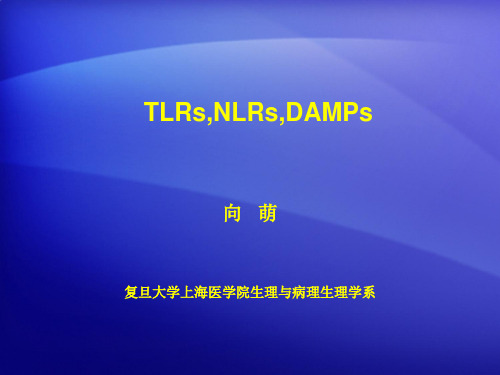
文献:
• Pathogen recognition and innate immunity, CELL,124,783-801,Feb 24,2006
• 炎症小体是一组参与免疫系统活化反应的复杂蛋白 质,是大多数多细胞动物一个古老的抗菌防卫体系 。当被激发时,炎症小体会启动一系列反应,导致 多种活性分子(如白细胞介素等)生成。
• 高浓度的ATP(5 mmoL/L)激活P2X7嘌呤能受体时 ,就会有大量的钾外流,此时细胞内低浓度的钾离 子([K+]<70mmol/L)就可激活炎症小体。
RIG样螺旋酶(RIG-like helicase,RLHs)
• 最近,研究发现三个具有DExD/H盒的同源RNA 螺旋酶RIG-I、MDA5和LGP2也可以作为胞浆内的 模式识别受体。
• RIG-I和MDA5可识别病毒来源的双链RNA,具有 识别不同病毒入侵。
• 当病毒感染时,细胞内大量产生双链RNA,由 RIG-1和MDA5识别双链DNA后激活NF-κB和IRF3 /7,从而诱导具有抗病毒作用的I型干扰素的生成 的功能。
Autoimmune and infectious diseases
associated with NLR polymorphisms/mutations NOD1 - H. pylori infection; Inflammatory bowel disease;
Asthma with high IgE levels NOD2 - Crohn’s disease; Early-onset sarcoidosis;
TLRs,NLRs,DAMPs
向萌
复旦大学上海医学院生理与病理生理学系
• 固有免疫是生物体在长期进化过程中形成的防御机制,主要特点是固 有免疫细胞表面或胞内的受体可识别多种“非己”异物共同表达的模 式分子,经特殊的信号转导途径表达效应分子以产生免疫效应。
模式识别受体Dectin-1的免疫学研究进展

doi:10.3969/j.issn.1000⁃484X.2018.07.028模式识别受体Dectin⁃1的免疫学研究进展①刘绍兰 吴婧楠 李若瑜② 栗玉珍 杨建勋 (哈尔滨医科大学附属第二医院皮肤科,哈尔滨150001) 中图分类号 R392.1 文献标志码 A 文章编号 1000⁃484X (2018)07⁃1102⁃06①本文为国家自然科学基金青年基金经费资助项目(81101228)和黑龙江省青年科学基金项目(QC2011CO48)㊂②北京大学第一医院皮肤科,北京100073㊂作者简介:刘绍兰,女,硕士,就读于哈尔滨医科大学,主要从事皮肤真菌感染方面的研究,E⁃mail:152********@㊂通讯作者及指导教师:杨建勋,女,博士,副主任医师,硕士生导师,主要从事皮肤真菌病方面的研究,E⁃mail:yangjianxun 76@㊂[摘 要] Dectin⁃1是C 型凝集素家族中最重要的受体,它能诱导自身胞内信号传导触发一系列细胞反应,在抗真菌免疫中发挥着重要的作用㊂该文对Dectin⁃1的信号传导途径㊁在抗微生物免疫中的作用㊁与其他受体的相互作用㊁在自身免疫及疾病中的作用㊁在β⁃葡聚糖诱导的免疫调节中的作用㊁潜在的临床应用予以综述㊂[关键词] Dectin⁃1;信号传导;抗微生物免疫;自身免疫;免疫调节Progress in immunology of pattern recognition receptor Dectin⁃1LIU Shao⁃Lan ,WU Jing⁃Nan ,LI Ruo⁃Yu ,LI Yu⁃Zhen ,YANG Jian⁃Xun .Department of Dermatology ,the Second Affiliated Hospital of Harbin Medical University ,Harbin 150001,China[Abstract ] Dectin⁃1,the most important receptor in the C⁃type lectin family,induces a series of cellular responses triggered by its own intracellular signaling and plays an important role in antifungal immunity.The signaling pathway to Dectin⁃1,its role in antimicrobial immunity,its interaction with other receptors,its role in autoimmunity and disease,its role in β⁃glucan⁃induced immune regulation,potential clinical applications are reviewed in this article.[Key words ] Dectin⁃1;Signal transduction;Anti⁃microbial immunity;Autoimmunity;Immunomodulation 高等动物固有免疫系统是机体抗真菌感染的第一道防线,固有免疫细胞(主要包括单核巨噬细胞㊁中性粒细胞)表面有多种模式识别受体(PRR),识别真菌细胞壁表面的病原相关分子模式(PAMP)㊂固有免疫系统对入侵病原微生物的识别是成功清除病原体的首要步骤㊂近期研究发现,C 型凝集素受体家族成员Dectin⁃1成为真菌感染免疫领域研究的热点[1]㊂既往研究表明Dectin⁃1是介导固有免疫细胞识别β⁃葡聚糖的主要受体㊂真菌感染之所以能被宿主细胞的受体识别并免疫杀伤,Dectin⁃1起到了不可或缺的作用㊂对于Dectin⁃1介导的免疫识别的研究为深入探索固有免疫防御机制开辟了新的领域㊂本文对Dectin⁃1的研究进展做一综述㊂1 Dectin⁃1概述Dectin⁃1是膜相关C 型凝集素(C⁃type lectin)家族中最重要的受体㊂含有细胞外碳水化合物识别结构域(CRD)或称C 型凝集素样区域(CTLD)㊁短杆(Stalk)连接的跨膜区和具有免疫受体酪氨酸活化基序(ITAM)的胞浆尾部㊂与其他C 型凝集素样受体不同,Dectin⁃1短杆区缺乏与形成二聚体相关的半胱胺酸残基,它是以单体形式发挥其生物功能的㊂人的Dectin⁃1基因通过转录后可产生8个亚型,2个主要亚型(A㊁B)和6个次要亚型(C㊁D㊁E㊁F㊁G㊁H)㊂其中只有三个亚型(A㊁B㊁E)同时具有完整的CRD 结构域和ITAM 基序㊂Dectin⁃1的A㊁B 两个亚型是主要的功能亚型,近来有研究发现Dectin⁃1E 亚型可以介导白念珠菌刺激引起的胞内信号通路的激活,并首次明确了Dectin⁃1E 亚型为功能亚型,可识别被吞进胞内的白念珠菌[2]㊂Dectin⁃1的细胞内结构域而非配体结合结构域决定着物种特异性配体[3]㊂Dectin⁃1能特异性识别可溶性及颗粒性β⁃1,3和/或β⁃1,6葡聚糖,如酵母多糖㊂酵母多糖刺激树突细胞产生IL⁃10的过程与Dectin⁃1依赖的细胞外信号调节激酶(ERK)及丝裂原活化蛋白激酶(MAPK)活化有关,近来有研究者推断细胞对酵母多糖的识别和结合可能另有其他信号通路来联合完成[4]㊂Dectin⁃1也可识别CD4+和CD8+T 淋巴细胞表面的内源性配体,促进T 淋巴细胞的增生[5]㊂在脾㊁淋巴结和胸腺的T 细胞区,巨噬细胞和树突状细胞Dectin⁃1的表达支持了这一受体在抗原提呈细胞和T 细胞间的联系作用㊂可以推测Dectin⁃1受体的功能可影响机体的免疫能力[6]㊂此外,Dectin⁃1与识别和摄取凋亡细胞以及细胞抗原的交叉提呈相关㊂2 Dectin⁃1的信号传导途径Dectin⁃1受体下游信号的级联反应可分为依赖脾脏酪氨酸激酶(Syk)的NF⁃κB 信号通路和非依赖脾脏酪氨酸激酶(Syk)的NF⁃κB 信号通路,以及Dectin⁃1受体的其他通路(图1[7])㊂2.1 Syk 依赖通道 Dectin⁃1是TLR 家族以外第一个被发现的可产生自身细胞内信号的PRR㊂当Dectin⁃1结合其配体后,ITAM 样基序中的酪氨酸首先被Src 家族激酶磷酸化,从而招募Syk,促进下游信号反应㊂Dectin⁃1只有近膜端含有ITAM 序列的酪氨酸是信号传导所必需的,可能是通过桥联两图1 Dectin⁃1受体的信号通路Fig.1 Dectin⁃1receptor signaling pathwayNote:Signaling network of Dectin⁃1.Multiple pathways downstream ofDectin⁃1rely on Syk.This can lead to PLCγ2/Ca2+signalingleading to PKCδactivation that controls calcineurin /NFAT and ROS /NLRP3in flammasome,and the phosphorylation of CARD9⁃Bcl10⁃Malt1.The CARD9complex is able to activate all NF⁃κBsubunits including c⁃Rel by removing its inhibitor,IκB,throughactivation of the IKK complex.Syk can also activate IKK complex through the noncanonical NIK pathway,leading to the activation ofNF⁃κB subunits RelB and p52.This pathway can be inhibited theRaf⁃1⁃mediatedpathwayinvolvingp65.Phosphorylatedandacetylated p65can interact with RelB,sequestering it away from anactive NF⁃κB complex.Resultant activation of NFAT and NF⁃κBresults in modification of gene transcription including cytokinesand chemokines.Dashed arrows represent a pathway that has yet to be fully defined.个Dectin⁃1单体促发的[8]㊂单一酪氨酸基序活化信号传导途径的发现是这一领域的一个重大突破㊂现已证实至少有其他两种受体 CLEC9A 和CLEC2也可利用这一信号传导途径[8⁃10]㊂Syk 是介导大多数Dectin⁃1功能的中枢性激酶,Syk 下游信号传导连接一种新的衔接子CARD9,可启动Syk /CARD9⁃BCL10⁃MALT1级联途径,激活NF⁃κB,最终诱导细胞因子产生㊂其中活化的NF⁃κB 亚基主要是C⁃Rel 和P65,C⁃Rel 亚基可激活Th17细胞释放IL⁃23p19和IL⁃1β,与机体抗致病性念珠菌的感染密切相关[11]㊂最近有研究报道,Dectin⁃1/Syk /ROS /NLRP3通路途径的活化能触发炎症复合体,并且对于巨噬细胞限制寄生虫复制是非常重要的,能有效地对抗宿主对寄生虫的感染[12]㊂此外,Dectin⁃1被认为是第1个能够诱导非典型NF⁃κB 途径的模式识别受体[13]㊂活化的Syk 首先激活NF⁃κB 诱导酶(NIK),后者直接调节NF⁃κB 的合成和激活IKKα,诱导基因转录[14]㊂2.2 非Syk 依赖通道 近年来的研究倾向于认为非Syk 依赖通道与丝氨酸⁃苏氨酸激酶Raf⁃1有关[13]㊂Dectin⁃1受体结合β葡聚糖后,DED 基序活化,激活Ras,进一步激活Raf⁃1,诱导NF⁃κB 合成㊂Raf⁃1可使p65磷酸化,与RelB 形成P65⁃RelB 二聚体,促进DNA 的转录;也可促使IL⁃12p70的合成,诱导Th1细胞分化成熟;还可诱导Th17细胞合成IL⁃23㊁IL⁃1β㊁IL⁃6等[15]㊂Gringhuis 等[16]证实了Raf⁃1的活化受Dectin⁃1受体干扰而不受Syk 影响,并阐明了非依赖Syk 通路中Dectin⁃1受体通过Raf⁃1通路激活了NF⁃κB,诱导细胞因子的分泌,不依赖于Syk 的作用㊂2.3 Dectin⁃1受体的其他通路 Dectin⁃1受体诱导的通路中,还涉及其他转录因子的活化,如活化T细胞核因子的激活(NFAT)㊂在依赖Syk 的NF⁃κB 通路中,PLCγ活化可诱导可溶性IP3,作用于内质网上的钙离子通道,促进Ca 2+释放,胞内Ca 2+浓度的升高激活钙调磷酸酶,使NFAT 去磷酸化,调节基因转录,并使树突细胞IL⁃10和IL⁃2的合成增加㊂与Dectin⁃1受体相互作用的PRR 有TLRS,如TLR4㊁TLR2㊁TLR9㊁TLR7和TLR5等㊂TLRs 依赖的Syk 通路与依赖的MyD88通路能相互作用,协同促进细胞因子的释放㊂Dectin⁃1受体与CR3相互作用时,能使感染灶的嗜中性粒细胞聚集和ROS 的合成增多[17],从而激活MAPK 和PI3K,诱导NF⁃κB 合成㊂最新研究显示Dectin⁃1介导的Syk㊁MAPKsPI3K和NF⁃κB信号传导途径的激活有助于镰刀菌刺激的CXCL⁃8从BEAS⁃2B细胞释放,这为开发临床过敏新型治疗策略提供了重要依据[18]㊂3 在抗微生物免疫中的作用β⁃葡聚糖是真菌细胞壁的主要成分,占细胞壁干重的50%~60%㊂Dectin⁃1可介导识别多种真菌病原体,包括酵母菌属㊁念珠菌属㊁曲霉属㊁肺孢子菌属等㊂通过Dectin⁃1识别这些菌体可促进保护性应答反应,包括通过细胞吞噬作用对配体的摄取,呼吸爆发,花生四烯酸以及大量细胞因子和趋化因子的产生,包括TNF㊁IL⁃1α㊁CXCL2㊁IL⁃1β㊁IL⁃6[19]㊂但是,Dectin⁃1识别也可产生非保护性细胞因子,如IL⁃23和IL⁃10㊂树突状细胞产生IL⁃23是依赖于Dectin⁃1且由β⁃葡聚糖介导的过程[20]㊂IL⁃23可促进Th17反应,而该反应可抑制Th1的保护性反应,促进有害的炎症反应㊂相关研究显示Dectin⁃1通过MSK1/2和CREB依赖性途径调节IL⁃10的产生并促进调节性巨噬细胞标记物的诱导[21]㊂通过这个途径产生的IL⁃10能介导炎症的发生[22],在真菌感染时起负性调节作用,促进真菌持续存在以及长期免疫应答㊂Dectin⁃1识别真菌依赖于β⁃葡聚糖,Dectin⁃1是针对真菌致病形态(发芽的孢子㊁菌丝)非常重要的免疫分子,如非粒细胞缺乏肺曲霉病患者中血清Dectin⁃1水平就明显增高[23]㊂β⁃葡聚糖暴露既可于真菌细胞壁表面,又可于某些特殊区域,如芽痕㊂真菌病原体还可通过隐藏β⁃葡聚糖来避免宿主对其免疫识别,如菌丝㊂菌丝的发生是侵袭性曲霉病形成的基础㊂白念珠菌在宿主体内经历酵母相到菌丝相形态改变,有助于其毒力产生㊂酵母形态可诱导宿主Dectin⁃1介导保护性反应而菌丝形态则不能,菌丝可通过隐藏β⁃葡聚糖避免免疫识别,并有助于菌体与宿主共生,这种逃避识别β⁃葡聚糖受体Dectin⁃1的方式在真菌病原体中广泛存在㊂但是,促进β⁃葡聚糖暴露也可有利于抗真菌反应㊂有学者研究表明,虽然曲霉和念珠菌的菌丝不暴露β⁃葡聚糖,但是通过卡泊芬净处理后,菌体表面β⁃葡聚糖增加,继而增加巨噬细胞释放TNF和CXCL2等炎症反应[24]㊂研究表明,Dectin⁃1还识别分枝杆菌[25]㊂但有趣的是,分枝杆菌并不表达β⁃葡聚糖㊂其与Dectin⁃1相互作用的配体尚不清楚㊂Dectin⁃1可通过未知的配体识别分枝杆菌,同样该受体也可促进分枝杆菌的摄取并产生细胞因子及趋化因子㊂其中值得关注的是Dectin⁃1与TLR2合作激活巨噬细胞对分枝杆菌感染的促炎反应有重要作用[26]㊂相关体外研究提示Dectin⁃1可能与TLR2协作,诱导细胞因子的产生,包括IL⁃12,这些反应可能与结核分枝杆菌的吞噬有关[27]㊂但还有待于进一步研究㊂4 Dectin⁃1与其他受体的相互作用除了β⁃葡聚糖,真菌细胞壁还有其他PAMPS 被多种受体共同识别㊂一些受体的识别出现在真菌摄入及吞噬体成熟的不同阶段㊂研究发现Dectin⁃1在对病原微生物的识别中可与TLRs信号转导发挥协同作用㊂在巨噬细胞, Dectin⁃1与TLR2联合在抗真菌反应中产生TNF,这首次证明了TLR与非TLR的相互作用[28]㊂Dectin⁃1的ITAM样信号转导基序在活化时发生酪氨酸磷酸化,该受体可被募集到包含酵母多糖颗粒的吞噬体㊂在巨噬细胞和树突状细胞,Dectin⁃1可与其他MYD88偶联的TLRs(TLR2㊁TLR4㊁TLR5㊁TLR7㊁TLR9)相互作用,TLRs诱导NF⁃κB的信号转导并产生多种细胞因子,包括:TNF㊁IL⁃10㊁IL⁃6㊁IL⁃23㊂这些反应可被Dectin⁃1增强㊂同样,TLR信号传导还可以增强Dectin⁃1激发的ROS产生㊂因此, Dectin⁃1和TLR直接识别微生物成分所激发的炎症反应呈协同性和非依赖性㊂这些提示通过不同家族天然免疫受体对微生物成分的协同识别是调控炎症反应的关键环节㊂Dectin⁃1受体还可识别真菌其他未知结构,诱导IL⁃12的产生,但目前机制尚不明确[29]㊂同时,这些相互作用也可导致IL⁃12下调㊂对IL⁃12及IL⁃23的负向调节似乎有助于Dectin⁃1介导的Th17反应[30]㊂它们均需要Dectin⁃1介导的Syk和Raf⁃1信号传导途径[13]㊂除此之外,Dectin⁃1可与SIGNR1协同结合真菌,与DC⁃SIGN共刺激引起花生四烯酸代谢,促发炎症反应㊂另外,Dectin⁃1还与四穿膜区蛋白质(traspanin)CD63以及CD37相互作用,使Dectin⁃1稳定于质膜上并介导IL⁃6产生㊂最新研究显示Dectin⁃1的表达还和TLR2/TLR3/TLR4受体有关,可能是建立在TLR2/TLR4对烟曲霉早期识别的基础上,TLR3可能起协同作用[31]㊂5 Dectin⁃1在自身免疫及疾病中的作用Dectin⁃1作为细胞活化的受体可有助于炎症性疾病的发展㊂目前,比较确实的证据来自β⁃葡聚糖可诱导SKG小鼠发生类风湿性关节炎,此外β⁃葡聚糖诱导的关节炎可被Dectin⁃1阻断[32],这表明, Dectin⁃1介导的炎症反应与自身免疫性关节炎的发展相关㊂最新研究显示Dectin⁃1通过激活CD11b+树突状细胞在变应性气道炎症中发挥重要作用[33],这可能与变应性哮喘严重程度相关㊂此外,研究表明Dectin⁃1的表达与白塞病的关节症状相关[34]㊂PTPN22基因内的单核苷酸多态性是一种诱发多种自身免疫性疾病的强烈遗传风险因子㊂目前研究显示PTPN22是一种新的Dectin⁃1信号调节剂,这提供了基因赋予的天然受体信号传导干扰和自身免疫性疾病风险之间的联系[35]㊂6 Dectin⁃1在β⁃葡聚糖诱导的免疫调节中的作用 作为β⁃葡聚糖主要受体,Dectin⁃1在其免疫调节作用中起重要作用,Dectin⁃1诱导的许多细胞反应都与β⁃葡聚糖在体内的作用相关㊂β⁃葡聚糖可诱导树突细胞成熟成为重要的专职抗原提呈细胞(professional APCs),APCs与T细胞相互作用可促进其活化㊂因此,作为β⁃葡聚糖的受体,存在于树突细胞的Dectin⁃1可决定T细胞的活化状态㊂此外,Dectin⁃1及其信号传导通路缺陷可影响颗粒性β⁃葡聚糖诱导的炎症反应[36]㊂相关研究显示,敲除Dectin⁃1基因或Dectin⁃1信号通路被受体激动剂凝胶多糖干扰或阻断,髓系细胞的吞噬和杀伤真菌的功能将受到明显抑制[37]㊂近年来研究利用封闭性单克隆抗体证明Dectin⁃1有助于抗肿瘤活性[38]㊂虽然还没有实验室证据,但推测Dectin⁃1可能通过共刺激TLR反应有助于β⁃葡聚糖的抗感染活性㊂最近研究表明抑制Dectin⁃1介导的信号传导是潜在的免疫疗法,其可与其他免疫疗法协同用于胰腺癌患者的治疗[39]㊂7 潜在的临床应用相关动物实验显示外周血粒细胞表达的Dectin⁃1水平与真菌感染相关,推测Dectin⁃1很可能是真菌感染的一种重要标识[40],此外,最新研究显示TLR2和dectin⁃1水平可能作为治疗或诊断烟曲霉感染的有希望的生物标志物[41]㊂由于β⁃葡聚糖可以出现在真菌感染的患者血液内,因此有学者建议可利用Dectin⁃1制成探针,检测血液中颗粒性及可溶性β⁃葡聚糖㊂现已合成可溶性嵌合型Dectin⁃1,它含有胞外小鼠受体的CRD及短杆区并与人类IgG Fc段融合㊂实验表明它可检测到活的真菌细胞壁β⁃葡聚糖[42]㊂因此,其在真菌感染的诊断中有潜在的应用价值㊂利用Dectin⁃Fc融合蛋白可增强SCID小鼠杀伤卡氏肺孢子菌的能力并减少肺组织的菌载量㊂同样,该融合蛋白可增强小鼠肺组织巨噬细胞杀伤烟曲霉,降低肺菌载量从而降低了侵袭性肺曲霉病小鼠的死亡率[43]㊂最新研究发现FcRγ可以负调节树突状细胞(DC)中的Dectin⁃1反应,根据Dectin⁃1在微生物和肿瘤细胞反应中的作用,推测Dectin⁃1可能在疫苗和癌症治疗发展中有潜在的应用价值[44]㊂最新研究显示食物来源的β⁃葡聚糖可通过Dectin⁃1⁃IL⁃17F⁃钙卫蛋白轴来控制特定的共生微生物群以维持肠内稳态[45]㊂这提示了肠道紊乱疾病治疗的一种新方法㊂临床上大量免疫缺损患者对真菌表现较高的易感性,而大量研究证实,β⁃葡聚糖与Dectin⁃1受体间的作用方式影响着这些糖类的免疫调节活性㊂因此,其在免疫调节活性方面的研究有十分巨大的潜在应用价值㊂8 总结及展望对Dectin⁃1的研究使我们更深入了解固有免疫及适应性免疫的功能㊂它的发现解决了多年来关于这一受体分子存在的争议㊂其在组织㊁细胞的广泛表达为该受体的生物学研究和免疫细胞识别β⁃葡聚糖开辟了新的视角㊂目前已经越来越多地了解了这一受体的信号传导途径以及它与其他受体的相互作用㊂就Dectin⁃1对于β⁃葡聚糖免疫调控能力而言,无疑是一个新的治疗性药物设计靶点㊂进一步对Dectin⁃1在体内作用研究以及深入探讨Dectin⁃1与其他受体相互作用的关系可能是未来抗真菌免疫机制的研究重点,并将有助于推动以β⁃葡聚糖为基础的抗感染和抗肿瘤治疗研究㊂参考文献:[1] 骆雪萍.真菌细胞壁病原相关分子模式TLR/Dectin⁃1通路及相关细胞因子的免疫作用[J].细胞与分子免疫学杂志,2014, 30(8):892⁃895.LUO XP.Effect of TLR/Dectin⁃1pathway and related cytokines on fungal cell⁃wall pathogens[J].J Cell Mol Immunol,2014,30(8): 892⁃895.[2] 董碧麟,李东升,段逸群,等.Dectin⁃1内在化表达介导氧依赖性方式杀伤白色念珠菌[J].中华微生物学和免疫学杂志, 2012,32(7):577⁃584.Dong BL,Li DS,Duan YQ,et al.Internalization of Dectin⁃1 mediates oxygen⁃dependent killing of Candida albicans[J].Chin J Microbiol Immunol,2012,32(7):577⁃584.[3] Takano T,Motozono C,Imai T,et al.Dectin⁃1intracellular domaindetermines species⁃specific ligand spectrum by modulating receptor sensitivity[J].J Biol Chem,2017,292(41):16933. [4] Hardison SE,Brown GD.C⁃type lectin receptors orchestrateantifungal immunity[J].Nature Immunol,2012,13(9):817.[5] Plato A,Willment JA,Brown GD.C⁃type lectin⁃like receptors ofthe dectin⁃1cluster:ligands and signaling pathways[J].Intern Rev Immunol,2013,32(2):134.[6] Upchurch K,Oh S,Joo H.Dectin⁃1in the control of Th2⁃type Tcell responses[J].Receptors Clin Invest,2016,3(1):e1094.[7] Plato A,Willment JA,Brown GD.C⁃type lectin⁃like receptors ofthe dectin⁃1cluster:ligands and signaling pathways[J].Intern Rev Immunol,2013,32(2):134⁃156.[8] Fuller GLJ,Williams JAE,Tomlinson MG,et al.The C⁃type lectinreceptors CLEC⁃2and Dectin⁃1,but not DC⁃SIGN,signal via a novel YXXL⁃dependent signalling cascade[J].J Biol Chem, 2007,282(17):12397.[9] Huysamen C,Willment JA,Dennehy KM,et al.CLEC9A is a novelactivation C⁃type lectin⁃like receptor expressed on BDCA3+ dendritic cells and a subset of monocytes[J].J Biol Chem,2008, 283(24):16693.[10] Huysamen C,Brown GD.The fungal pattern recognition receptor,Dectin⁃1,and the associated cluster of C⁃type lectin⁃like receptors[J].Fems Microbiology Letters,2009,290(2):121. [11] Si G,Ba W,Tm K,et al.Selective C⁃Rel activation via Malt1controls anti⁃fungal TH⁃17immunity by dectin⁃1and dectin⁃2[J].PLoS Pathog,2011,7(1):e1001259.[12] Lima⁃Junior DS,Twp M,Vlg C,et al.Dectin⁃1activation duringleishmania amazonensis phagocytosis prompts syk⁃dependentreactive oxygen species production to trigger inflammasomeassembly and restriction of parasite replication[J].J Immunol,2017,199(6):ji1700258.[13] Gringhuis SI,Den DJ,Litjens M,et al.Dectin⁃1directs T helpercell differentiation by controlling noncanonical NF⁃kappaBactivation through Raf⁃1and Syk[J].Nature Immunol,2009,10(2):203.[14] Yang H,He H,Dong Y.CARD9Syk⁃dependent and Raf⁃1Syk⁃independent signaling pathways in target recognition of Candidaalbicans by Dectin⁃1[J].Eur J Clin Microbiol Infect Dis,2011,30(3):303.[15] Deng Z,Ma S,Zhou H,et al.Tyrosine phosphatase SHP⁃2mediates C⁃type lectin receptor⁃induced activation of the kinaseSyk and anti⁃fungal TH17responses[J].Nature Immunol,2015,16(6):642.[16] Gringhuis SI,Dunnen JD,Litjens M,et al.Dectin⁃1directs Thelper cell differentiation by controlling noncanonical NF⁃[kappa]B activation through Raf⁃1and Syk[J].NatureImmunol,2009,10(2):203.[17] Li X,Utomo A,Cullere X,et al.Theβ⁃glucan receptor dectin⁃1activates the integrin mac⁃1in neutrophils via vav proteinsignaling to promote candida albicans clearance[J].Cell HostMicrobe,2011,10(6):603⁃615.[18] Yeh CC,Horng HC,Hong C,et al.Dectin⁃1⁃mediated pathwaycontributes to fusarium proliferatum⁃induced CXCL⁃8release fromhuman respiratory epithelial cells[J].Intern J Mole Sci,2017,18(3):624.[19] Vautier S,Sousa MD,Brown GD.C⁃type lectins,fungi and Th17responses[J].Cytokine Growth Factor Rev,2010,21(6):405.[20] Dennehy KM,Willment JA,Williams DL,et al.Reciprocalregulation of IL⁃23and IL⁃12following co⁃activation of Dectin⁃1and TLR signaling pathways[J].Eur J Immunol,2010,39(5):1379⁃1386.[21] Elcombe SE,Naqvi S,Bosch MWMVD,et al.Dectin⁃1regulatesIL⁃10production via a MSK1/2and CREB dependent pathwayand promotes the induction of regulatory macrophage markers[J].PLoS One,2013,8(3):e60086.[22] 赵 莹,骆雪萍,张 雪,等.Dectin⁃1在热处理光滑假丝酵母菌刺激大鼠气道上皮细胞中的作用及对IL⁃10和TNF⁃α表达的影响[J].中国感染控制杂志,2017,16(1):10⁃15.Zhao Y,Luo XP,Zhang X,et al.Dectin⁃1′s effect on heat⁃treated smooth muscle cells of rat airway epithelial cells and itseffect on IL⁃10and TNF⁃αexpression[J].Chin J InfectionControl Magazine,2017,16(1):10⁃15.[23] 徐小勇,陈 菲,高卫卫,等.非粒细胞缺乏肺曲霉病患者血清Dectin⁃1的检测[J].中国感染与化疗杂志,2014,14(4):301⁃304.Xu XY,Chen F,Gao WW,et al.Detection of serum Dectin⁃1inpatients with non⁃granulocyte⁃deficient pulmonary aspergillosis[J].Chin J Infection Chemotherapy,2014,14(4):301⁃304.[24] Hohl TM,Feldmesser M,Perlin DS,et al.Caspofungin modulatesinflammatory responses to aspergillus fumigatus through stage⁃specific effects on fungalβ⁃glucan exposure[J].J InfectiousDis,2008,198(2):176⁃185.[25] Tsoni SV,Brown GD.beta⁃Glucans and dectin⁃1[J].Ann N YAcad Sci,2008,1143(1143):45.[26] Yadav M,Schorey JS.The beta⁃glucan receptor dectin⁃1functionstogether with TLR2to mediate macrophage activation bymycobacteria[J].Blood,2006,108(9):3168⁃3175. [27] Shin DM,Yang CS,Yuk JM,et al.Mycobacterium abscessusactivates the macrophage innate immune response via a physicaland functional interaction between TLR2and dectin⁃1[J].Cellular Microbiol,2008,10(8):1608⁃1621.[28] Brown GD.Dectin⁃1:a signalling non⁃TLR pattern⁃recognitionreceptor[J].Nat Rev Immunol,2006,6(1):33. [29] Sancho D,Reis ESC.Signaling by myeloid C⁃type lectin receptorsin immunity and homeostasis[J].Ann Rev Immunol,2012,30(1):491.[30] Rivera A,Hohl TM,Collins N,et al.Dectin⁃1diversifiesAspergillus fumigatus⁃specific T cell responses by inhibiting Thelper type1CD4T cell differentiation[J].J Exp Med,2011,208(2):369.[31] 栗 方,曹 彬,曲久鑫,等.Dectin⁃1和TLR2/TLR3/TLR4受体在免疫缺陷小鼠侵袭性肺曲霉菌病的表达[J].中华临床医师杂志:电子版,2015,9:1626⁃1631.Li F,Cao B,Qu JX,et al.Expression of Dectin⁃1and TLR2/TLR3/TLR4receptors in invasive pulmonary aspergillosis in im⁃munodeficient mice[J].Clin J China Clinicians,2015,9:1626⁃1631[32] Dan JM,Kelly RM,Lee CK,et al.Role of the mannose receptor ina murine model of cryptococcus neoformans infection[J].Infection Immunity,2008,76(6):2362⁃2367.[33] Ito T,Hirose K,Norimoto A,et al.Dectin⁃1plays an importantrole in house dust mite⁃induced allergic airway inflammationthrough the activation of CD11b+dendritic cells[J].J Immunol,2017,198(1):69⁃70.[34] Choi B,Suh CH,Kim HA,et al.The correlation of CD206,CD209,and disease severity in behet′s disease with arthritis[J].Mediators Inflammation,2017,2017(2):7539529. [35] Purvis HA,Clarke F,Jordan CK,et al.Protein TyrosinePhosphatase PTPN22regulates IL⁃1βdependent Th17responsesby modulating dectin⁃1signaling in mice[J].Eur J Immunol,2018,48(2):306⁃315.[36] Leibundgut⁃Landmann S,Gross O,Robinson MJ,et al.Syk⁃andCARD9⁃dependent coupling of innate immunity to the inductionof T helper cells that produce interleukin17[J].Nat Immunol,2007,8(6):630⁃638.[37] Taylor PR,Tsoni SV,Willment JA,et al.Dectin⁃1is required forbeta⁃glucan recognition and control of fungal infection[J].Nature Immunology,2006,8(1):31.[38] Ikeda Y,Adachi Y,Ishii T,et al.Blocking effect of anti⁃Dectin⁃1antibodies on the anti⁃tumor activity of1,3⁃beta⁃glucan and thebinding of Dectin⁃1to1,3⁃beta⁃glucan[J].Biol Pharm Bull,2007,30(8):1384⁃1389.[39] Daley D,Mani VR,Mohan N,et al.Dectin1activation onmacrophages by galectin9promotes pancreatic carcinoma andperitumoral immune tolerance[J].Nature Med,2017,23(5):556⁃567.[40] Ozmentskelton TR,Fluiter EAD,Ha TZ,et al.Leukocyte Dectin⁃1expression is differentially regulated in fungal versuspolymicrobial sepsis[J].Critical Care Medicine,2009,37(3):1038⁃1045.[41] Zhang PP,Xin XF,Xu XY,et al.Toll⁃like receptor2and dectin⁃1function as promising biomarker for Aspergillus fumigatusinfection[J].Exp Ther Med,2017,14(4):3836⁃3840. [42] Graham LM,Tsoni SV,Willment JA,et al.Soluble Dectin⁃1as atool to detect beta⁃glucans[J].J Immunol Methods,2006,314(1⁃2):164⁃169.[43] Mattila PE,Metz AE,Rapaka RR,et al.Dectin⁃1Fc targeting ofaspergillus fumigatus beta⁃glucans augments innate defenseagainst invasive pulmonary aspergillosis[J].Antimicrob AgentsChemother,2008,52(3):1171⁃1172.[44] Pan YG,Yu YL,Lin CC,et al.FcεRIγ⁃Chain NegativelyModulates Dectin⁃1Responses in Dendritic Cells[J].FrontImmunol,2017,8:1424.[45] Kamiya T,Tang C,Kadoki M,et al.beta⁃Glucans in food modifycolonic microflora by inducing antimicrobial protein,calprotectin,in a Dectin⁃1⁃induced⁃IL⁃17F⁃dependent manner[J].MucosalImmunol,2017:doi:10.1038/mi.2017.86.[收稿2017⁃12⁃21 修回2018⁃01⁃22](编辑 倪 鹏)㊃征稿征订㊃‘中国免疫学杂志“征稿㊁征订启事 ‘中国免疫学杂志“是中国免疫学会会刊,是公开发行的全国性学术期刊,为基础医学㊁生物学的核心期刊,是美国‘化学文摘“(CA)的源期刊,为中国科学引文数据库㊁中国学术期刊文摘㊁中国生物医学文摘的来源期刊㊂曾获全国百强科技期刊㊁第二届国家期刊奖百种重点期刊㊁中国首批期刊方阵 双效”期刊㊁第四届中国精品科技期刊㊁首届北方优秀期刊奖㊂本刊主要栏目有专家述评㊁基础免疫学㊁中医中药与免疫㊁生物治疗㊁临床免疫学㊁免疫学技术与方法㊁教学园地㊁专题综述㊁短篇快讯㊁信息速递等㊂本刊为月刊,A4开本,160页,铜版纸印刷,彩图随文㊂定价18.00元/本,216.00元/年,邮发代号12⁃89,全国邮局均可订阅㊂为减轻自费读者负担,对自费个人订户实行8折优惠,16.00元/本(含邮费);中国免疫学会会员订户每本14.5元(免费邮寄)㊂如错过订阅时间可直接汇款到‘中国免疫学杂志“编辑部,请注明所购卷期㊁册数及 自费”字样㊂同时欢迎医药㊁生物制剂㊁医疗器械厂家刊登广告及作者网上投稿㊂本刊目前仅接收在线投稿,为了提高稿件处理速度,希望广大作者在投稿时留下常用的电子邮箱㊁手机或其他联系电话,保证编辑部与作者间的沟通更快捷㊁及时㊂地址:长春市建政路971号‘中国免疫学杂志“编辑部 邮编:130061(传真)电话:0431-******** E⁃mail:zhmizazh@ 网址:。
模式识别受体名词解释
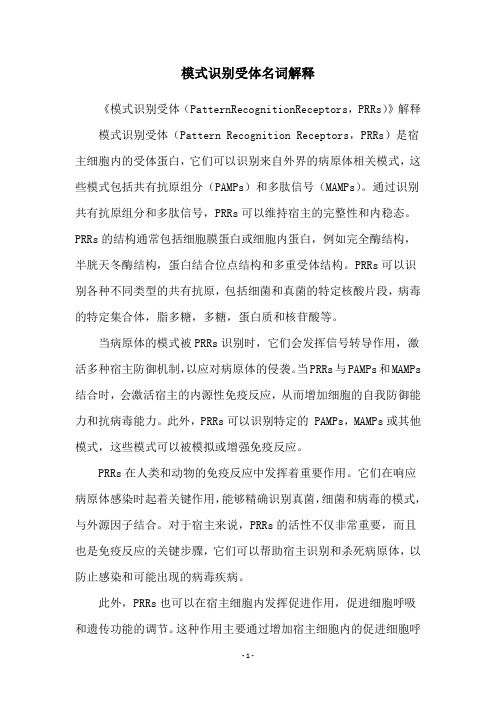
模式识别受体名词解释《模式识别受体(PatternRecognitionReceptors,PRRs)》解释模式识别受体(Pattern Recognition Receptors,PRRs)是宿主细胞内的受体蛋白,它们可以识别来自外界的病原体相关模式,这些模式包括共有抗原组分(PAMPs)和多肽信号(MAMPs)。
通过识别共有抗原组分和多肽信号,PRRs可以维持宿主的完整性和内稳态。
PRRs的结构通常包括细胞膜蛋白或细胞内蛋白,例如完全酶结构,半胱天冬酶结构,蛋白结合位点结构和多重受体结构。
PRRs可以识别各种不同类型的共有抗原,包括细菌和真菌的特定核酸片段,病毒的特定集合体,脂多糖,多糖,蛋白质和核苷酸等。
当病原体的模式被PRRs识别时,它们会发挥信号转导作用,激活多种宿主防御机制,以应对病原体的侵袭。
当PRRs与PAMPs和MAMPs 结合时,会激活宿主的内源性免疫反应,从而增加细胞的自我防御能力和抗病毒能力。
此外,PRRs可以识别特定的 PAMPs,MAMPs或其他模式,这些模式可以被模拟或增强免疫反应。
PRRs在人类和动物的免疫反应中发挥着重要作用。
它们在响应病原体感染时起着关键作用,能够精确识别真菌,细菌和病毒的模式,与外源因子结合。
对于宿主来说,PRRs的活性不仅非常重要,而且也是免疫反应的关键步骤,它们可以帮助宿主识别和杀死病原体,以防止感染和可能出现的病毒疾病。
此外,PRRs也可以在宿主细胞内发挥促进作用,促进细胞呼吸和遗传功能的调节。
这种作用主要通过增加宿主细胞内的促进细胞呼吸和遗传功能的PRR蛋白表达来实现。
同样,PRRs在识别致病物,激活防御机制,以及促进细胞的生长和发育方面也发挥着重要作用。
因此,PRRs是宿主细胞内一类非常重要的受体蛋白质,它们能够识别外源模式,并使用这些模式来激活宿主免疫应答,促进细胞的生长和发育,保护宿主细胞免受外来影响的破坏,为宿主抵御微生物和病毒的入侵提供强大的保护。
toll样受体信号通路

Toll 样受体(TLRs)是一个模式识别受体家族,它们在进化上高度保守,从线虫到哺乳动物都存在TLRs,目前在哺乳动物中已发现 12 个成员[1].TLRs 主要表达于抗原递呈细胞及一些上皮细胞,为玉型跨膜蛋白,胞外区具有富含亮氨酸的重复序列,能够特异识别病原微生物进化中保守的抗原分子———病原相关分子模式 (pathogen-associatedmolecular patterns, PAMPs)[2].为了有效地抵抗入侵的病原体,机体需要对多种 PAMPs 产生适当的免疫应答,TLRs 可以通过识别 PAMPs 诱发抵抗病原体的免疫反应.而且 TLRs 也参与识别有害的内源性物质.TLRs 的激活可诱导很强的免疫反应,有利于机体抵抗病原体感染或组织损伤,但是过度的免疫反应也会带来不利影响,如产生内毒素休克、自身免疫性疾病等.为了保证 TLRs 介导正确的免疫应答,机体存在精密的负调控机制,及时抑制 TLRs 信号,维持机体的免疫平衡[3]TLR 家族成员(TLR3 除外)诱导的炎症反应都经过一条经典的信号通路(图 1),该通路起始于TLRs 的一段胞内保守序列———Toll/IL-1 受体同源区(Toll/IL-1 receptor homologous region,TIR).TIR可激活胞内的信号介质———白介素 1 受体相关蛋白激酶 (IL-1R associated kinase, IRAK) IRAK-1 和IRAK-4、肿瘤坏死因子受体相关因子 6(TNFR-associated factor 6, TRAF-6)、促分裂原活化蛋白激酶(mitogen activated protein kinase,MAPK)和 I资B激酶 (I资B kinase, I资K ),进而激活核因子资B(nuclear factor 资B,NF-资B),诱导炎症因子的表达.TLRs 信号通路上的许多接头蛋白都具有 TIR结构域:髓系分化因子 88(myeloid differentiationfactor 88, MyD88)、MyD88- 接头蛋白相似物(MyD88-adaptor like,Mal)、含有 TIR 结构能诱导干扰素茁的接头分子 (TIR domain-containingadaptor inducing interferon 茁,TRIF)、TRIF 相关接头分子(TRIF-related adaptor molecule,TRAM)和SARM (sterile 琢 and armadillo motif-containingprotein)[4].它们参与 TLRs 所介导的信号转导,其中MyD88 最重要,参与了除 TLR3 外所有 TLRs介导的信号转导.MyD88 首先通过 TIR 与 TLRs 相结合,接着募集下游信号分子 IRAK-4,IRAK-4 磷酸化激活IRAK-1,随后活化 TRAF6.活化的 TRAF6 具有泛素连接酶(E3)的活性,能够结合泛素结合酶(E2),进而泛素化降解 IKK-酌.这种泛素化降解可以活化TGF-茁激酶(TGF-茁 activated kinase 1, TAK1) 和TAK1 结合蛋白 (TAK1 binding protein, TAB1、TAB2、TAB3).活化的 TAK1 会催化 IKK-茁磷酸化,最终激活 NF-资B,促使炎症因子的表达.除了共同的 NF-资B 激活通路,不同的 TLRs 还存在着其特有的信号通路,一些TLRs 具有募集 Mal、TRAM 和 TRIF 的作用.不同的接头分子在信号传导中发挥的作用不同[5],TRIF 在脂多糖(LPS)激活的 TLR4 途径和 Poly(I∶C)激活的 TLR3 途径中都起到了重要的作用,而 TRAM 仅在 TLR4 的途径中发挥作用.TLRs 的激活是一把双刃剑,它可以通过刺激先天性免疫应答和提高获得性免疫反应来保护机体,但是它所引起的持续性炎症反应也会对机体产生损伤,自身免疫、慢性炎症和感染性疾病都与它有一定关系.例如LPS 持续刺激TLR4 就可以引起严重的败血病和感染性休克,此外,类风湿性关节炎、慢性阻塞性肺心病、结肠炎、哮喘、心肌病、狼疮和动脉粥样硬化的发生也与 TLRs 的激活有关.因此 TLRs 的激活必须受到严格的负调控,以保持免疫系统的稳定.对于负调控机理的研究是近几年免疫学的热点,以下将介绍 TLRs 负调控的研究进展(图 1).。
固有免疫模式识别受体与药物研究
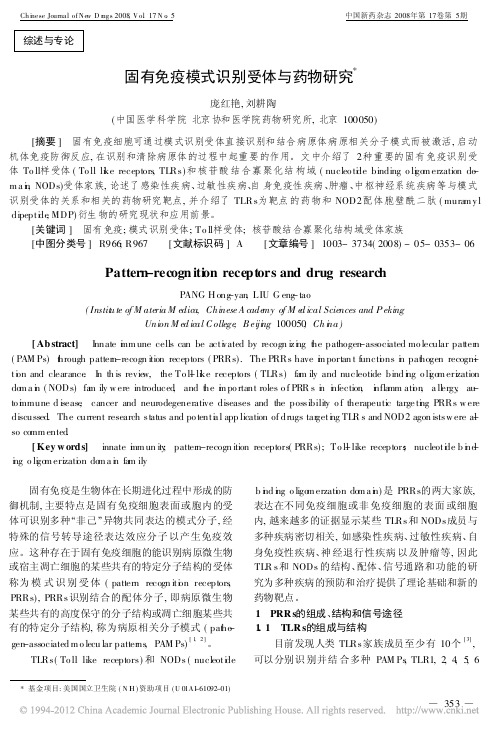
Pattern-recogn ition receptors and drug research
dapter like ), TR IF ( T IR-dom a in-containing adeptor m o lecu le induc ing IFN-B)和 TRAM ( T r i-f re lated adapto r m o lecu le), TLR 的 信号转导途径常 分为 M yD88 依赖途径和 M yD88 非 依赖 途径, 多 数 TLR s 包括 TLR1, 2, 4, 5, 6, 7和 9信号中都有 M yD88 的参与。 1. 2. 1 M yD88 依赖性 信号途径 M yD88 的 N-和 C-末端分别有一个死亡受体结构域和 T IR 结构域, TLRs与相应配体结合引起受体 ( 同源或异源 ) 二聚 化, 受体胞质区 T IR 通过嗜同作用募集 M yD88 接头 蛋白, M yD88 通过死亡结构域 ( death dom a in, DD) 嗜 同作用募集含有死亡结构域的 IL-1 受体相关激酶 ( IL-1R-associated k inases, IRAKs), IRAK 通过磷酸 化作 用被 激活, 与肿 瘤坏 死因 子受 体相关 因子 6 ( TNFR-associated factor 6, TRAF6) 结合, 并进 一步 与 TAB-1, TAB-2 和 TGF-B 激活的激酶 ( TGF-B-act ived k inase, TAK ) 1 形 成复 合 物, TAK-1 再 激 活 IKKA / IKKB / IKKC( IJB kinase) , IKKB 将 IJB 磷酸 化, 磷酸化的 IJB 通过泛素化降解, NF-JB 被解离进 入核内, 启动多种炎性细胞因子、黏附分子基因的转 录表达。另外, TLRs还可以活化 MAPK ( M itogen-act ivated prote in k inase signa ling cascades) 途径, 活化 多种转录因子如 AP-1, E lk-1等。 1. 2. 2 M yD88 非 依赖性途径 研究发现, M yD88 缺陷小鼠对 TLR2, TLR7 和 TLR9 配基引起的刺激
模式识别受体

模式识别受体概述模式识别是指通过计算机或人的智能系统,识别和分析输入数据中的模式或规律。
在模式识别的过程中,我们经常使用一种重要的组件,称为模式识别受体。
模式识别受体指的是一种接收和处理输入数据的系统或部分,其功能是将输入数据与先前学习到的模式进行比较,并根据比较结果做出判断或分类。
这些受体可以是硬件设备,如传感器、摄像头等,也可以是软件程序,如计算机视觉、自然语言处理等。
本文将介绍模式识别受体的基本原理、分类以及在不同领域中的应用。
原理模式识别受体的工作原理基于信息处理和模式匹配的原理。
当输入数据传递给模式识别受体时,它首先对数据进行预处理和特征提取。
预处理过程可以包括噪声去除、数据缩放等操作,而特征提取过程则是将输入数据中的重要特征提取出来,以减少数据维度和非关键信息。
接下来,模式识别受体将提取的特征与先前学习到的模式进行比较。
这些模式可以是确定的模式,也可以是通过机器学习算法学习得到的模式。
比较过程中,模式识别受体会计算输入数据与每个模式之间的相似度或距离度量。
根据相似度或距离度量的大小,模式识别受体可以做出判断或分类。
分类模式识别受体可以根据其工作方式和应用领域进行分类。
下面以工作方式分类为例进行介绍:监督式学习监督式学习是指模式识别受体在训练阶段同时使用输入数据和对应的输出标签,以建立输入数据与输出之间的映射关系。
在训练完成后,模式识别受体可以根据输入数据对其进行分类或判断。
常见的监督式学习算法包括支持向量机(SVM)、决策树、神经网络等。
无监督式学习无监督式学习是指模式识别受体在训练阶段只使用输入数据,而没有对应的输出标签。
在训练完成后,模式识别受体可以根据输入数据的内在结构进行分类、聚类或异常检测。
常见的无监督式学习算法包括聚类分析、主成分分析(PCA)、自组织映射(SOM)等。
半监督式学习半监督式学习是介于监督式学习和无监督式学习之间的一种学习方式。
在半监督式学习中,模式识别受体使用部分有标签数据和大量无标签数据进行训练。
模式识别受体及其信号转导机制的研究进展

模式识别受体及其信号转导机制的研究进展安华章第二军医大学免疫学教研室医学免疫学国家重点实验室免疫识别--免疫反应发生发展的基础“自我”(self)“非我”(nonself)免疫应答immune response免疫耐受immune tolerance)机体防御系统系统的组成Turvey SE. et al. J Allergy Clin Immunol. Feb 2010; 125(2 Suppl 2): S24–S32固有免疫研究起始于19世纪后叶吞噬细胞(1883)Metchnikoff E开创了固有免疫研究先河, 获1908诺贝尔奖炎症的发生起始于固有免疫细胞对病原的识别固有免疫细胞的活化促进获得性免疫反应的发生Akira S. Proc Jpn Acad Ser B Phys Biol Sci. Apr 2009; 85(4): 143–1567抗原提呈细胞调节获得性免疫反应的类型Anne Cooke. Rev Diabet Stud. 2006 Summer;3(2):72-75免疫细胞如何识别并区分不同种类病原体并发生适当的免疫反应?Pattern recognition非克隆性表达的PRR识别不同种类的PAMP,诱导不同类型的细胞因子产生Ruslan Medzhitov and Charles A Janeway JrCurrent Opinion in Immunology 1997, 9:4-9•“病原相关分子模式”(pathogen associated molecular pattern,PAMP):一类或一群特定的微生物病原体(及其产物)共有的某些非特异性、高度保守的分子结构,可被固有免疫细胞所识别。
如:LPS、LTA、细菌DNA、病毒RNA/DNA•“模式识别受体” (pattern-recognition receptors,PRR)是一类主要表达于天然免疫细胞表面、非克隆性分布的分子,可识别一种或多种PAMP或DAMP并活化免疫细胞、介导固有免疫反应。
TBK1-IRF3信号通路
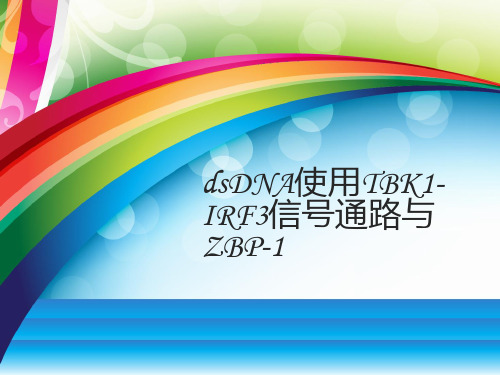
3
(1)免疫刺激效应只限于B型dsDNA
在我们对DNA免疫刺激效应理解上的下一步飞跃始于意识到当被直接导入细胞 质时非病原菌来源的DNA也是有免疫刺激性的。在我们实验室的调查中揭示 dsDNA,当用胞质转染法转染时是一个IFN-Ⅰ和趋化因子基因如Cxd10,Cd5和 Cd2潜在的诱导物在小鼠和人的树突细胞以及间质细胞。关于免疫原性的条件 在添加的CpGDNA和转染的dsDNA之间是不同的。如果不考虑这些序列,胞质 dsDNA仍然是有刺激性的并且可以诱导IFN-Ⅰ即使当它是甲基化的。这不只限 于病原来源的DNA,因为当转染时那些缺乏CpG岛的小牛胸腺和人造DNA和 E.coli以及HSV-1有相同的刺激性。此外,之前被证明由于缺乏TLR9表达而对 CpG无反应的小鼠胚胎成纤维细胞当用DNA转染时表现出IFN-Ⅰ的诱导效应。 这种dsDNA的IFN-Ⅰ刺激效应依赖于它的长度。长的dsDNA诱导更强的IFN-Ⅰ 反应。
2/24/2019
3 Z-DNA结合蛋白-1(ZBP-1)
ZBP-1,也被认为是DNA依赖的干扰素调节因子(DAI)和DLM-1的激活物,是继 TLR9之后最早被发现的胞浆DNA感受器。在被发现是胞浆DNA感受器之前,ZBP1被认为在调节mRNA代谢中起作用并且作为肿瘤相关的蛋白参与主体对抗细胞压 力反应。这是一个IFN-可诱导的基因产物最初被报道通过两个结合域结合Z-DNA。
病毒入侵后模式识别受体通过识别病原相关分子模式经线粒体抗病毒信号传送蛋白mavs等接头蛋白传递信号激活下游激酶复合体如ikkikkaikk和tbk1ikk通过不同机制活化转录因子irf3引起i型ifn及抗病毒细胞因子表达ifn进一步激活ifn信号通路刺激数百个ifn刺激基因isg表达并由isg启动抗病毒效应
模式识别受体通路

SnapShot: Pattern-Recognition ReceptorsTaro Kawai and Shizuo Akira Research Institute for Microbial Diseases, Osaka University, Osaka, Japan1024.e1 Cell 129, June 1, 2007 ©2007 Elsevier Inc. DOI 10.1016/j.cell.2007.05.017 (A) T oll-like receptor signaling. T oll-like receptor (TLR) 3 recognizes polyinosinic-polycytidylic acid (poly IC), whereas TLR4 recognizes lipopolysaccharide (LPS). TLR2 recog-nizes various components such as lipoprotein and peptidoglycan (PGN). TLR5 detects flagellin. TLR7 and TLR9 detect single-stranded (ss)RNA and CpG DNA, respectively. Each TLR recruits a distinct set of T oll/interleukin-1 receptor (TIR) domain-containing adaptor molecules such as myeloid differentiation primary response gene 88 (MyD88), TIR-containing adaptor protein (TIRAP , also known as MAL), TIR-containing adaptor-inducing IFN β (TRIF , also known as TICAM1) and TRIF-related adaptor molecule (TRAM, also known as TICAM2). TLR3 uses TRIF , and TLR5, 7, and 9 use MyD88. TLR2 uses MyD88 and TIRAP , and TLR4 uses MyD88, TIRAP , TRIF , and TRAM. MyD88 binds to inter-leukin-1 receptor-associated kinase 4 (IRAK4) and TRAF6. TRIF binds receptor-interacting protein 1 (RIP1) and TRAF6. TRAF6 forms a complex with Ubc13, Uev1A, and ECSIT (evolutionarily conserved signaling intermediate in T oll/IL-1R pathways) to activate a complex containing transforming growth factor-β-activated kinase 1 (TAK1), TAK1-binding protein 1 (TAB1), TAB2, and TAB3. TAK1 activates I κB kinase (IKK) complex consisting of IKK α, IKK β, and Nemo (also known as IKK γ), which results in the phosphorylation and proteasomal degradation of I κB proteins and the release of a transcription factor NF κB to the nucleus to regulate expression of inflammatory cytokines such as interleukin-6 (IL-6) and tumor necrosis factor α (TNF α). TAK1 simultaneously activates the MAPK (JNK, p38, and ERK) pathway, leading to activation of AP-1 that controls expression of inflammatory cytokines. TRIF recruits TRAF3, which interacts with IKK-related kinases, TANK-binding kinase 1 (TBK1, also known as T2K and NAK), and IKKi (also known as IKK ε). These kinases, together with adaptors TANK and NAP1, catalyze the phosphorylation of IRF3. Phosphorylated IRF3 forms a dimer, translocates into the nuclei, binds to DNA, and regulates the expression of interferon β (IFN β) in collaboration with AP-1 and NF κB. IRF3 is also activated by phosphatidylinositol 3 kinase (PI3K), which interacts with TLR3. In TLR2, 4, 5, 7, and 9 signaling, IRF5 is recruited to the MyD88-IRAK4-TRAF6 complex, then translocates into the nuclei to control the induction of inflammatory cytokines. In TLR7 and 9 signaling, a signaling complex consisting of TRAF3, osteopontin (OPN), IRAK1, IKK α, and IRF7 is recruited to the MyD88-IRAK4-TRAF6 complex. IRF7 is phosphorylated by IRAK1 and IKK α, forms a dimer, and translocates into the nuclei to express IFN α and IFN β genes. IRF1 is also recruited to the MyD88-IRAK4-TRAF6 complex and participates in TLR7- and 9-mediated production of IL-12 p35, inducible nitric oxide synthase (iNOS), and IFN β. Unc93B, a twelve-pass membrane protein local-ized to the endoplasmic reticulum (ER), is required for the activation of signaling pathways triggered by TLR3, 7, and 9.(B) RIG-I like RNA helicase signaling. After recognition of viral RNA, retinoic acid-inducible gene-I (RIG-I) and Mda5 recruit IFN β promoter stimulator-1 (IPS-1, also known as MAVS, Cardif, and VISA) via CARD-CARD (caspase recruitment domain) interaction. IPS-1 is localized to mitochondria and acts as an adaptor that links RIG-I-like RNA helicase (RLH) and the TRAF3 complex, which subsequently activates IRF3 and IRF7 in a TBK1- and IKKi-dependent manner. IPS-1 also interacts with the Fas-associated death domain protein (FADD), which is required for the activation of IRF3 and NF κB. FADD interacts with and activates caspase-10 (Casp-10) and Casp-8, driving NF κB activation.(C) NOD-like receptor signaling. Nucleotide-binding oligomerization domain 1 (NOD1, also known as CARD4) and NOD2 (also known as CARD15) detect PGN-derived molecules diaminopimelic acid (DAP) and muramyl dipeptide (MDP), respectively, and recruit RIP2 (also known as RICK or CARDIAK) to activate NF κB. NOD2 also recruits CARD9 to facilitate the MAPK pathway. MDP is also detected by NACHT -LRR-PYD-containing protein 3 (NALP3, also known as cryopyrin or PYPAF1), which forms an inflammasome along with ASC (apoptosis-associated speck-like protein containing a CARD) and Casp-1, inducing the processing of pro-IL-1β and pro-IL-18 that results in the release of IL-1β and IL-18, respectively. Bacterial RNA, toxin, monosodium urate crystal (MSU), ATP , or infection with Listeria or Staphylococcus trig-gers IL-1β and IL-18 releases via the NALP3 inflammsome. Detection of flagellin released into cytosol following Legionella infection is dependent on IL-1β-converting enzyme protease-activating factor (IPAF , also known as CLAN or CARD12) and neuronal apoptosis inhibitor protein 5 (NAIP5, also known as Birc1e). IPAF also partici-pates in the recognition of Salmonella . IPAF and NAIP5 trigger Casp-1 activation as well as cell death. NALP1b-mediated Casp-1 activation is linked to susceptibility of mouse macrophages to lethal toxin of Bacillus anthracis .(D) Lectin signaling. C-type lectin Dectin-1 binds to β-glucan found in fungal cell wall components to activate tyrosine kinase Syk, which leads to the activation of CARD9. Activated CARD9 forms a complex with Bcl-10 and MALT1 to activate NF κB.(E) Unknown pathway. Double-stranded (ds)DNA released by DNA viruses, bacteria, and damaged host cells trigger induction of IFN β via TBK1/IKKi-dependent mechanisms.(F) Negative regulators. An E3 ubiquitin ligase Triad3A downregulates TLR expression, and members the of IL-1 receptor family, SIGIRR and ST2L, and a leucine-rich repeat (LRR)-containing cell-surface molecule RP105 inhibit TLR signaling (1). The function of MyD88 is blocked by a short form of MyD88 termed MyD88s (2), and the function of TRIF is suppressed by a TIR-domain-containing protein SARM and tyrosine phosphatase SHP2 (3). Suppressor of cytokine signaling 1 (SOCS1) mediates TIRAP degradation (4). Activation of IRAK4 is inhibited by IRAK-M, splicing variants of IRAK1 (IRAK1c) and IRAK2 (IRAK2c, IRAK2d), and Toll-interacting protein (Tollip)(5). Oligomerization and ubiquitination of TRAF6 are suppressed by β-arrestin and A20, respectively (6). IRF4 prevents a recruitment of IRF5 to the receptor complex(7) and PI3K negatively regulates the MAPK pathway (8). PIN1 mediates degradation of IRF3 to terminate type I IFN responses (9), and ATF3 and the nuclear hormone receptors such as PPAR γ and glucocorticoid receptor (GR) suppress expression of NF κB target genes (10). Casp-1 activation is negatively regulated by Pyrin and CARD-containing proteins such as Casp-12, CARD only protein (COP , also known as Pseudo-ICE), ICEBERG, and inhibitory CARD (INCA) (11).AbbreviationsIRF , interferon regulatory factorMAL, MyD88-adaptor-likeMAVS, mitochondrial antiviral signalingPYD, pyrin domainPYPAF1, Pyrin-containing Apaf-1-like protein 1RICK, RIP-like interacting caspase-like apoptosis-regulatory protein kinaseTANK, TRAF family member-associated NF κB activatorRefeRencesAkira, S., Uematsu, S., and Takeuchi, O. (2006). Pathogen recognition and innate immunity. Cell 124, 783–801.Fritz, J.H., Ferrero, R.L., Philpott, D.J., and Girardin, S.E. (2006). Nod-like proteins in immunity, inflammation and disease. Nat. Immunol. 7, 1250–1257.Honda, K., T akaoka, A., and T aniguchi, T . (2006). T ype I interferon gene induction by the interferon regulatory factor family of transcription factors. Immunity 25, 349–360.Ishii, K.J., and Akira, S. (2006). Innate immune recognition of, and regulation by, DNA. Trends Immunol. 27, 525–532.Kawai, T., and Akira, S. (2006). Innate immune recognition of viral infection. Nat. Immunol. 7, 131–137.Mariathasan, S., and Monack, D.M. (2007). Inflammasome adaptors and sensors: Intracellular regulators of infection and inflammation. Nat. Rev. Immunol. 7, 31–40.Meylan, E., and Tschopp, J. (2006). Toll-like receptors and RNA helicases: Two parallel ways to trigger antiviral responses. Mol. Cell 22, 561–569.Meylan, E., Tschopp, J., and Karin, M. (2006). Intracellular pattern recognition receptors in the host response. Nature 442, 39–44.Ogura, Y ., Sutterwala, F .S., and Flavell, R.A. (2006). The inflammasome: First line of the immune response to cell stress. Cell 126, 659–662.West, A.P ., Koblansky, A.A., and Ghosh, S. (2006). Recognition and signaling by toll-like receptors. Annu. Rev. Cell Dev. Biol. 22, 409–437.。
模式识别受体在肠炎中的功能及信号转导
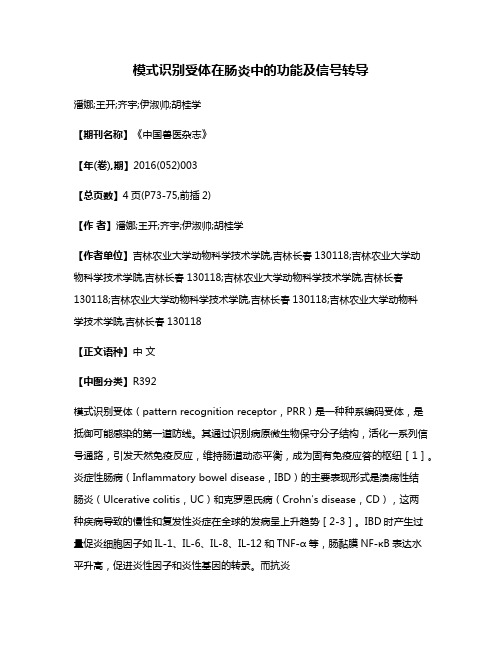
模式识别受体在肠炎中的功能及信号转导潘娜;王开;齐宇;伊淑帅;胡桂学【期刊名称】《中国兽医杂志》【年(卷),期】2016(052)003【总页数】4页(P73-75,前插2)【作者】潘娜;王开;齐宇;伊淑帅;胡桂学【作者单位】吉林农业大学动物科学技术学院,吉林长春130118;吉林农业大学动物科学技术学院,吉林长春130118;吉林农业大学动物科学技术学院,吉林长春130118;吉林农业大学动物科学技术学院,吉林长春130118;吉林农业大学动物科学技术学院,吉林长春130118【正文语种】中文【中图分类】R392模式识别受体(pattern recognition receptor,PRR)是一种种系编码受体,是抵御可能感染的第一道防线。
其通过识别病原微生物保守分子结构,活化一系列信号通路,引发天然免疫反应,维持肠道动态平衡,成为固有免疫应答的枢纽[1]。
炎症性肠病(Inflammatory bowel disease,IBD)的主要表现形式是溃疡性结肠炎(Ulcerative colitis,UC)和克罗恩氏病(Crohn′s disease,CD),这两种疾病导致的慢性和复发性炎症在全球的发病呈上升趋势[2-3]。
IBD时产生过量促炎细胞因子如IL-1、IL-6、IL-8、IL-12和TNF-α等,肠黏膜NF-κB表达水平升高,促进炎性因子和炎性基因的转录。
而抗炎目前,已经确定的TLRs人类有13种,鼠有10种,鱼有20余种。
PRR由胞外区、跨膜区和胞内区3个部分组成,属于I型跨膜蛋白。
TLR1、TLR2、TLR4,TLR5、TLR6和TLR10分布在细胞表面;TLR3、TLR7、TLR8、TLR9和TLR13分布在胞内囊泡上,其配体结构各不相同,涉及的信号转导通路分为两种类型:一类为MyD88非依赖型:TLR3、TLR4,通过干扰素调节因子3/7(IRF-3/-7)信号传导途径;另一类为MyD88依赖型:TLR1、TLR2、TLR4、TLR5、TLR6、TLR9等,介导NF-κB、丝裂原活化蛋白激酶(mitogen-activated protein kinases,MAPKs)、AP-1(activator protein-1)信号通路。
模式识别受体的种类及其作用
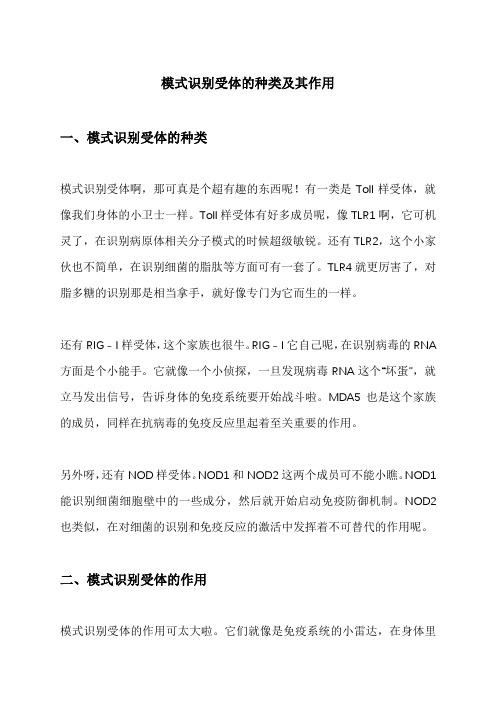
模式识别受体的种类及其作用一、模式识别受体的种类模式识别受体啊,那可真是个超有趣的东西呢!有一类是Toll样受体,就像我们身体的小卫士一样。
Toll样受体有好多成员呢,像TLR1啊,它可机灵了,在识别病原体相关分子模式的时候超级敏锐。
还有TLR2,这个小家伙也不简单,在识别细菌的脂肽等方面可有一套了。
TLR4就更厉害了,对脂多糖的识别那是相当拿手,就好像专门为它而生的一样。
还有RIG - I样受体,这个家族也很牛。
RIG - I它自己呢,在识别病毒的RNA 方面是个小能手。
它就像一个小侦探,一旦发现病毒RNA这个“坏蛋”,就立马发出信号,告诉身体的免疫系统要开始战斗啦。
MDA5也是这个家族的成员,同样在抗病毒的免疫反应里起着至关重要的作用。
另外呀,还有NOD样受体。
NOD1和NOD2这两个成员可不能小瞧。
NOD1能识别细菌细胞壁中的一些成分,然后就开始启动免疫防御机制。
NOD2也类似,在对细菌的识别和免疫反应的激活中发挥着不可替代的作用呢。
二、模式识别受体的作用模式识别受体的作用可太大啦。
它们就像是免疫系统的小雷达,在身体里到处扫描,寻找那些外来的病原体或者危险信号。
一旦发现了那些病原体相关分子模式,就像拉响了警报一样。
对于Toll样受体来说,它们被激活之后呢,就会启动一系列的信号转导通路。
这个过程就像是在传递军情一样,一层一层地把消息传递下去,最后让免疫细胞开始行动起来。
比如会促使炎症因子的释放,这些炎症因子就像是身体派出的小士兵,去对抗那些入侵的病原体。
RIG - I样受体呢,当它们识别了病毒RNA之后,会诱导产生干扰素。
干扰素就像是一种超级武器,不仅可以干扰病毒的复制,还能激活周围的细胞,让它们也进入防御状态,就好像把周围的细胞都武装起来了一样。
NOD样受体在细胞内发挥着重要的作用。
它们一旦识别了细菌的成分,就会激活一些炎症小体的形成。
炎症小体可是个很厉害的东西,它可以促使一些炎症因子的成熟和释放,让身体对细菌的入侵做出快速的反应。
模式识别受体范文
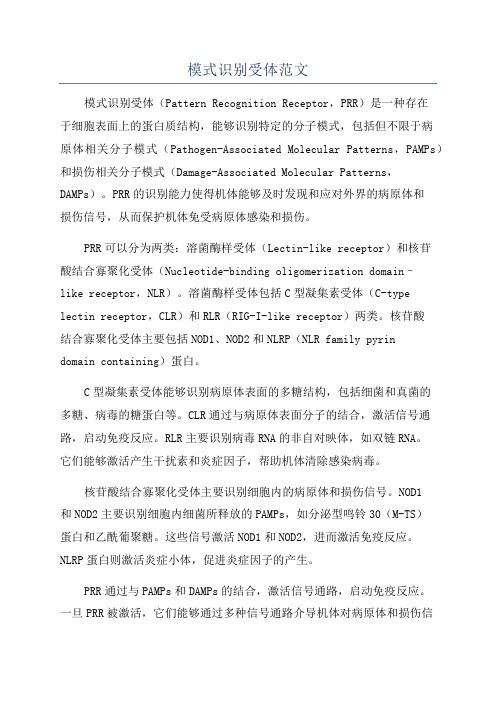
模式识别受体范文模式识别受体(Pattern Recognition Receptor,PRR)是一种存在于细胞表面上的蛋白质结构,能够识别特定的分子模式,包括但不限于病原体相关分子模式(Pathogen-Associated Molecular Patterns,PAMPs)和损伤相关分子模式(Damage-Associated Molecular Patterns,DAMPs)。
PRR的识别能力使得机体能够及时发现和应对外界的病原体和损伤信号,从而保护机体免受病原体感染和损伤。
PRR可以分为两类:溶菌酶样受体(Lectin-like receptor)和核苷酸结合寡聚化受体(Nucleotide-binding oligomerization domain–like receptor,NLR)。
溶菌酶样受体包括C型凝集素受体(C-typelectin receptor,CLR)和RLR(RIG-I-like receptor)两类。
核苷酸结合寡聚化受体主要包括NOD1、NOD2和NLRP(NLR family pyrindomain containing)蛋白。
C型凝集素受体能够识别病原体表面的多糖结构,包括细菌和真菌的多糖、病毒的糖蛋白等。
CLR通过与病原体表面分子的结合,激活信号通路,启动免疫反应。
RLR主要识别病毒RNA的非自对映体,如双链RNA。
它们能够激活产生干扰素和炎症因子,帮助机体清除感染病毒。
核苷酸结合寡聚化受体主要识别细胞内的病原体和损伤信号。
NOD1和NOD2主要识别细胞内细菌所释放的PAMPs,如分泌型鸣铃30(M-TS)蛋白和乙酰葡聚糖。
这些信号激活NOD1和NOD2,进而激活免疫反应。
NLRP蛋白则激活炎症小体,促进炎症因子的产生。
PRR通过与PAMPs和DAMPs的结合,激活信号通路,启动免疫反应。
一旦PRR被激活,它们能够通过多种信号通路介导机体对病原体和损伤信号的消除和清除。
NOD样受体信号通路介导先天免疫反应
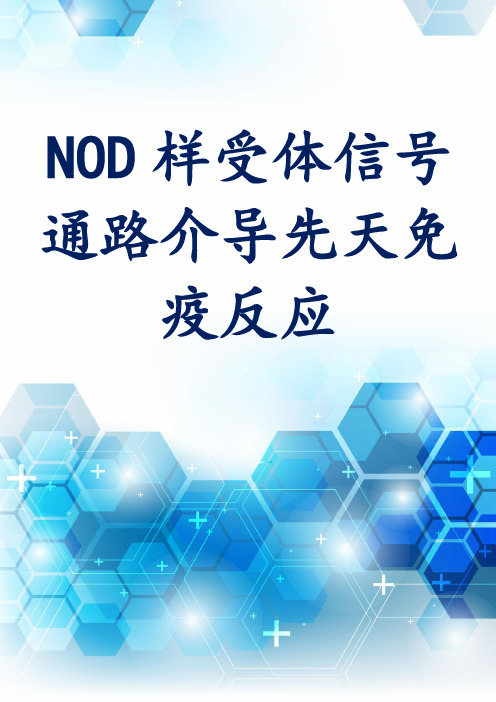
NOD样受体信号通路介导先天免疫反应一、先天免疫反应概述先天免疫是生物体抵抗病原体入侵的第一道防线,它不依赖于特定的抗原识别,而是通过一系列模式识别受体(PRRs)来识别病原体的共有分子模式。
NOD样受体(NLRs)是先天免疫系统中重要的一类PRRs,它们在细胞内识别病原体,激活下游信号通路,从而引发免疫反应。
NOD样受体信号通路在介导先天免疫反应中起着至关重要的作用。
1.1 NOD样受体的发现与分类NOD样受体(NLRs)是一类含有NOD结构域的蛋白质,最初在植物中被发现,后来在哺乳动物中也发现了类似的分子。
NLRs根据其结构和功能可以分为几个亚家族,包括NOD1、NOD2、NLRP1-14等。
这些受体通过其NOD结构域识别病原体的特定分子模式,如细菌的肽聚糖、病毒的RNA等。
1.2 先天免疫反应的激活机制当病原体入侵宿主细胞时,NLRs能够识别并结合这些病原体的分子模式,从而激活下游的信号通路。
这一过程通常涉及NLRs的寡聚化和激活,进而触发炎症小体的形成和活化。
炎症小体是一种多蛋白复合体,它能够激活caspase酶,进而促进炎症因子的成熟和分泌。
二、NOD样受体信号通路的分子机制NOD样受体信号通路的分子机制复杂多样,涉及多种信号分子和调控蛋白。
这些信号通路不仅能够激活炎症反应,还能够调节细胞死亡和免疫细胞的激活。
2.1 NOD样受体的激活与信号传导NLRs的激活通常需要病原体的直接或间接刺激。
例如,NOD1和NOD2能够识别细菌的肽聚糖片段,而NLRP3则能够响应多种炎症和应激信号。
一旦激活,NLRs会通过其NOD结构域发生寡聚化,形成炎症小体。
炎症小体的形成是NLRs 信号通路激活的关键步骤。
2.2 炎症小体的组装与活化炎症小体的组装涉及多个组分,包括NLRs、接头蛋白ASC(apoptosis-associated speck-like protein containing a CARD)和caspase酶。
模式识别受体PRR

32
四 NK T细胞
表达NK1.1和TCR-CD3
大多为CD4-CD8-,少数为CD4+
TCR的多样性低、抗原识别谱窄
可识别CD1提呈的脂类和糖脂类抗原
不受MHC限制
五 γδ T细胞
组成性表达TCRγδ-CD3复合受体分子 多为CD4-CD8-双阴性,TCR缺乏多样性 可直接识别某些完整的多肽抗原 分泌多种细胞因子,参与免疫调节
(二)NK细胞活性的调节
1.识别HLAⅠ类分子的NK细胞受体 (1)杀伤细胞免疫球蛋白样受体(KIR) (2)杀伤细胞凝集素样受体(KLR) 2.识别非HLAⅠ类分子的活化性受体 (1)NKG2D MHC classⅠchain-related molecule A/B ( MICA/B) (2)自然细胞毒性受体(NCR) 具体识别配体目前尚不清楚
六 B1细胞
主要分布于胸腔、腹腔和肠壁固有层 CD5+、mIgM+B细胞 BCR缺乏多样性
七 其他固有免疫细胞
肥大细胞(mast cell) 嗜碱性粒细胞 (basophil) 嗜酸性粒细胞 (eosinophil)
第三节 固有免疫体液分子及其主要作用
一 补体系统
细胞溶破作用 补体活化产物的作用
巨噬细胞
库普弗细胞 小胶质细胞 破骨细胞
其他
1.巨噬细胞表面受体及其识别的配体
(1)模式识别受体(patern recognition receptor,PRR)
是指单核 /巨噬细胞和树突状细胞等固有免疫
细胞表面或胞内器室膜上能够直接识别病原体某些
共有的特定分子结构的受体。
模式识别受体介导的病原免疫逃逸_胡茂志
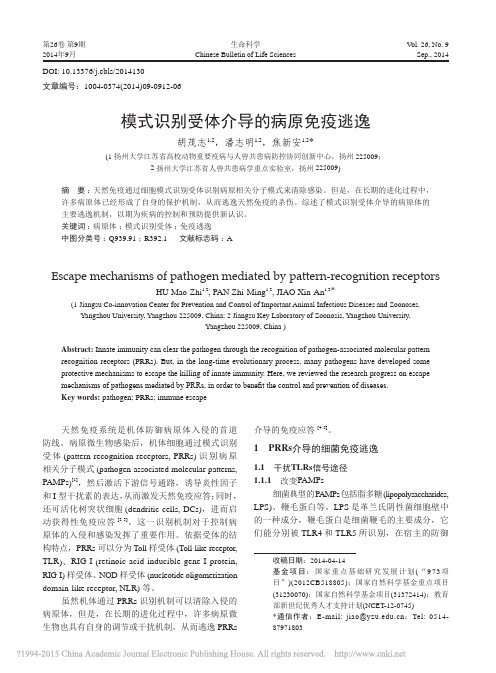
第26卷 第9期2014年9月生命科学Chinese Bulletin of Life Sciences V ol. 26, No. 9Sep., 2014文章编号:1004-0374(2014)09-0912-06DOI: 10.13376/j.cbls/2014130收稿日期:2014-04-14基金项目:国家重点基础研究发展计划(“973项目”)(2012CB518805);国家自然科学基金重点项目(31230070);国家自然科学基金项目(31372414);教育部新世纪优秀人才支持计划(NCET-12-0745)*通信作者:E-mail: jiao@ ;Tel: 0514-********模式识别受体介导的病原免疫逃逸胡茂志1,2,潘志明1,2,焦新安1,2*(1 扬州大学江苏省高校动物重要疫病与人兽共患病防控协同创新中心,扬州 225009;2 扬州大学江苏省人兽共患病学重点实验室,扬州 225009)摘 要:天然免疫通过细胞模式识别受体识别病原相关分子模式来清除感染。
但是,在长期的进化过程中,许多病原体已经形成了自身的保护机制,从而逃逸天然免疫的杀伤。
综述了模式识别受体介导的病原体的主要逃逸机制,以期为疾病的控制和预防提供新认识。
关键词:病原体;模式识别受体;免疫逃逸中图分类号:Q939.91;R392.1 文献标志码:A Escape mechanisms of pathogen mediated by pattern-recognition receptorsHU Mao-Zhi 1,2, PAN Zhi-Ming 1,2, JIAO Xin-An 1,2*(1 Jiangsu Co-innovation Center for Prevention and Control of Important Animal Infectious Diseases and Zoonoses,Yangzhou University, Yangzhou 225009, China; 2 Jiangsu Key Laboratory of Zoonosis, Yangzhou University,Yangzhou 225009, China )Abstract: Innate immunity can clear the pathogen through the recognition of pathogen-associated molecular pattern recognition receptors (PRRs). But, in the long-time evolutionary process, many pathogens have developed some protective mechanisms to escape the killing of innate immunity. Here, we reviewed the research progress on escape mechanisms of pathogens mediated by PRRs, in order to benefit the control and prevention of diseases.Key words: pathogen; PRRs; immune escape天然免疫系统是机体防御病原体入侵的首道防线。
- 1、下载文档前请自行甄别文档内容的完整性,平台不提供额外的编辑、内容补充、找答案等附加服务。
- 2、"仅部分预览"的文档,不可在线预览部分如存在完整性等问题,可反馈申请退款(可完整预览的文档不适用该条件!)。
- 3、如文档侵犯您的权益,请联系客服反馈,我们会尽快为您处理(人工客服工作时间:9:00-18:30)。
SnapShot: Pattern-Recognition ReceptorsTaro Kawai and Shizuo Akira Research Institute for Microbial Diseases, Osaka University, Osaka, Japan1024.e1 Cell 129, June 1, 2007 ©2007 Elsevier Inc. DOI 10.1016/j.cell.2007.05.017 (A) T oll-like receptor signaling. T oll-like receptor (TLR) 3 recognizes polyinosinic-polycytidylic acid (poly IC), whereas TLR4 recognizes lipopolysaccharide (LPS). TLR2 recog-nizes various components such as lipoprotein and peptidoglycan (PGN). TLR5 detects flagellin. TLR7 and TLR9 detect single-stranded (ss)RNA and CpG DNA, respectively. Each TLR recruits a distinct set of T oll/interleukin-1 receptor (TIR) domain-containing adaptor molecules such as myeloid differentiation primary response gene 88 (MyD88), TIR-containing adaptor protein (TIRAP , also known as MAL), TIR-containing adaptor-inducing IFN β (TRIF , also known as TICAM1) and TRIF-related adaptor molecule (TRAM, also known as TICAM2). TLR3 uses TRIF , and TLR5, 7, and 9 use MyD88. TLR2 uses MyD88 and TIRAP , and TLR4 uses MyD88, TIRAP , TRIF , and TRAM. MyD88 binds to inter-leukin-1 receptor-associated kinase 4 (IRAK4) and TRAF6. TRIF binds receptor-interacting protein 1 (RIP1) and TRAF6. TRAF6 forms a complex with Ubc13, Uev1A, and ECSIT (evolutionarily conserved signaling intermediate in T oll/IL-1R pathways) to activate a complex containing transforming growth factor-β-activated kinase 1 (TAK1), TAK1-binding protein 1 (TAB1), TAB2, and TAB3. TAK1 activates I κB kinase (IKK) complex consisting of IKK α, IKK β, and Nemo (also known as IKK γ), which results in the phosphorylation and proteasomal degradation of I κB proteins and the release of a transcription factor NF κB to the nucleus to regulate expression of inflammatory cytokines such as interleukin-6 (IL-6) and tumor necrosis factor α (TNF α). TAK1 simultaneously activates the MAPK (JNK, p38, and ERK) pathway, leading to activation of AP-1 that controls expression of inflammatory cytokines. TRIF recruits TRAF3, which interacts with IKK-related kinases, TANK-binding kinase 1 (TBK1, also known as T2K and NAK), and IKKi (also known as IKK ε). These kinases, together with adaptors TANK and NAP1, catalyze the phosphorylation of IRF3. Phosphorylated IRF3 forms a dimer, translocates into the nuclei, binds to DNA, and regulates the expression of interferon β (IFN β) in collaboration with AP-1 and NF κB. IRF3 is also activated by phosphatidylinositol 3 kinase (PI3K), which interacts with TLR3. In TLR2, 4, 5, 7, and 9 signaling, IRF5 is recruited to the MyD88-IRAK4-TRAF6 complex, then translocates into the nuclei to control the induction of inflammatory cytokines. In TLR7 and 9 signaling, a signaling complex consisting of TRAF3, osteopontin (OPN), IRAK1, IKK α, and IRF7 is recruited to the MyD88-IRAK4-TRAF6 complex. IRF7 is phosphorylated by IRAK1 and IKK α, forms a dimer, and translocates into the nuclei to express IFN α and IFN β genes. IRF1 is also recruited to the MyD88-IRAK4-TRAF6 complex and participates in TLR7- and 9-mediated production of IL-12 p35, inducible nitric oxide synthase (iNOS), and IFN β. Unc93B, a twelve-pass membrane protein local-ized to the endoplasmic reticulum (ER), is required for the activation of signaling pathways triggered by TLR3, 7, and 9.(B) RIG-I like RNA helicase signaling. After recognition of viral RNA, retinoic acid-inducible gene-I (RIG-I) and Mda5 recruit IFN β promoter stimulator-1 (IPS-1, also known as MAVS, Cardif, and VISA) via CARD-CARD (caspase recruitment domain) interaction. IPS-1 is localized to mitochondria and acts as an adaptor that links RIG-I-like RNA helicase (RLH) and the TRAF3 complex, which subsequently activates IRF3 and IRF7 in a TBK1- and IKKi-dependent manner. IPS-1 also interacts with the Fas-associated death domain protein (FADD), which is required for the activation of IRF3 and NF κB. FADD interacts with and activates caspase-10 (Casp-10) and Casp-8, driving NF κB activation.(C) NOD-like receptor signaling. Nucleotide-binding oligomerization domain 1 (NOD1, also known as CARD4) and NOD2 (also known as CARD15) detect PGN-derived molecules diaminopimelic acid (DAP) and muramyl dipeptide (MDP), respectively, and recruit RIP2 (also known as RICK or CARDIAK) to activate NF κB. NOD2 also recruits CARD9 to facilitate the MAPK pathway. MDP is also detected by NACHT -LRR-PYD-containing protein 3 (NALP3, also known as cryopyrin or PYPAF1), which forms an inflammasome along with ASC (apoptosis-associated speck-like protein containing a CARD) and Casp-1, inducing the processing of pro-IL-1β and pro-IL-18 that results in the release of IL-1β and IL-18, respectively. Bacterial RNA, toxin, monosodium urate crystal (MSU), ATP , or infection with Listeria or Staphylococcus trig-gers IL-1β and IL-18 releases via the NALP3 inflammsome. Detection of flagellin released into cytosol following Legionella infection is dependent on IL-1β-converting enzyme protease-activating factor (IPAF , also known as CLAN or CARD12) and neuronal apoptosis inhibitor protein 5 (NAIP5, also known as Birc1e). IPAF also partici-pates in the recognition of Salmonella . IPAF and NAIP5 trigger Casp-1 activation as well as cell death. NALP1b-mediated Casp-1 activation is linked to susceptibility of mouse macrophages to lethal toxin of Bacillus anthracis .(D) Lectin signaling. C-type lectin Dectin-1 binds to β-glucan found in fungal cell wall components to activate tyrosine kinase Syk, which leads to the activation of CARD9. Activated CARD9 forms a complex with Bcl-10 and MALT1 to activate NF κB.(E) Unknown pathway. Double-stranded (ds)DNA released by DNA viruses, bacteria, and damaged host cells trigger induction of IFN β via TBK1/IKKi-dependent mechanisms.(F) Negative regulators. An E3 ubiquitin ligase Triad3A downregulates TLR expression, and members the of IL-1 receptor family, SIGIRR and ST2L, and a leucine-rich repeat (LRR)-containing cell-surface molecule RP105 inhibit TLR signaling (1). The function of MyD88 is blocked by a short form of MyD88 termed MyD88s (2), and the function of TRIF is suppressed by a TIR-domain-containing protein SARM and tyrosine phosphatase SHP2 (3). Suppressor of cytokine signaling 1 (SOCS1) mediates TIRAP degradation (4). Activation of IRAK4 is inhibited by IRAK-M, splicing variants of IRAK1 (IRAK1c) and IRAK2 (IRAK2c, IRAK2d), and Toll-interacting protein (Tollip)(5). Oligomerization and ubiquitination of TRAF6 are suppressed by β-arrestin and A20, respectively (6). IRF4 prevents a recruitment of IRF5 to the receptor complex(7) and PI3K negatively regulates the MAPK pathway (8). PIN1 mediates degradation of IRF3 to terminate type I IFN responses (9), and ATF3 and the nuclear hormone receptors such as PPAR γ and glucocorticoid receptor (GR) suppress expression of NF κB target genes (10). Casp-1 activation is negatively regulated by Pyrin and CARD-containing proteins such as Casp-12, CARD only protein (COP , also known as Pseudo-ICE), ICEBERG, and inhibitory CARD (INCA) (11).AbbreviationsIRF , interferon regulatory factorMAL, MyD88-adaptor-likeMAVS, mitochondrial antiviral signalingPYD, pyrin domainPYPAF1, Pyrin-containing Apaf-1-like protein 1RICK, RIP-like interacting caspase-like apoptosis-regulatory protein kinaseTANK, TRAF family member-associated NF κB activatorRefeRencesAkira, S., Uematsu, S., and Takeuchi, O. (2006). Pathogen recognition and innate immunity. Cell 124, 783–801.Fritz, J.H., Ferrero, R.L., Philpott, D.J., and Girardin, S.E. (2006). Nod-like proteins in immunity, inflammation and disease. Nat. Immunol. 7, 1250–1257.Honda, K., T akaoka, A., and T aniguchi, T . (2006). T ype I interferon gene induction by the interferon regulatory factor family of transcription factors. Immunity 25, 349–360.Ishii, K.J., and Akira, S. (2006). Innate immune recognition of, and regulation by, DNA. Trends Immunol. 27, 525–532.Kawai, T., and Akira, S. (2006). Innate immune recognition of viral infection. Nat. Immunol. 7, 131–137.Mariathasan, S., and Monack, D.M. (2007). Inflammasome adaptors and sensors: Intracellular regulators of infection and inflammation. Nat. Rev. Immunol. 7, 31–40.Meylan, E., and Tschopp, J. (2006). Toll-like receptors and RNA helicases: Two parallel ways to trigger antiviral responses. Mol. Cell 22, 561–569.Meylan, E., Tschopp, J., and Karin, M. (2006). Intracellular pattern recognition receptors in the host response. Nature 442, 39–44.Ogura, Y ., Sutterwala, F .S., and Flavell, R.A. (2006). The inflammasome: First line of the immune response to cell stress. Cell 126, 659–662.West, A.P ., Koblansky, A.A., and Ghosh, S. (2006). Recognition and signaling by toll-like receptors. Annu. Rev. Cell Dev. Biol. 22, 409–437.。
